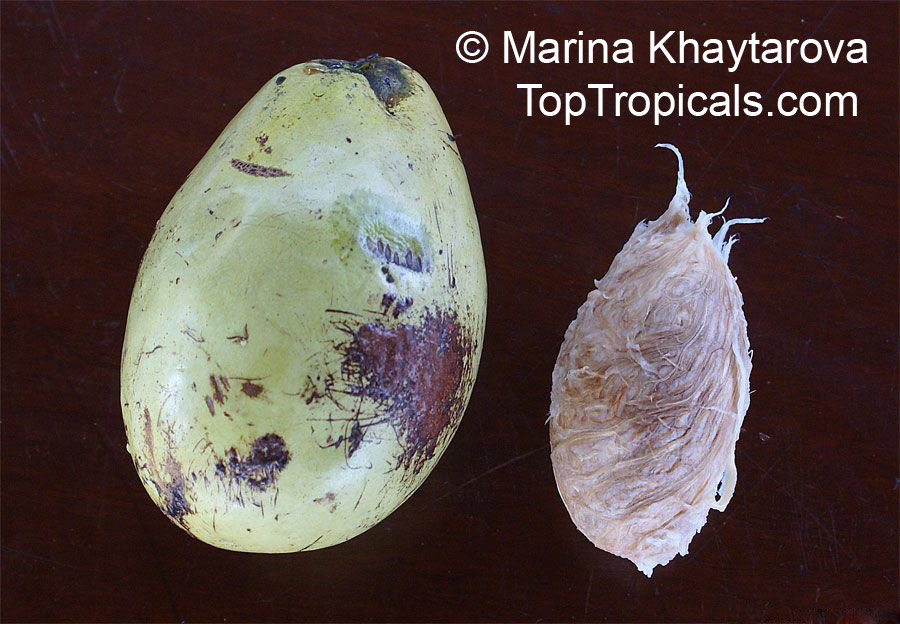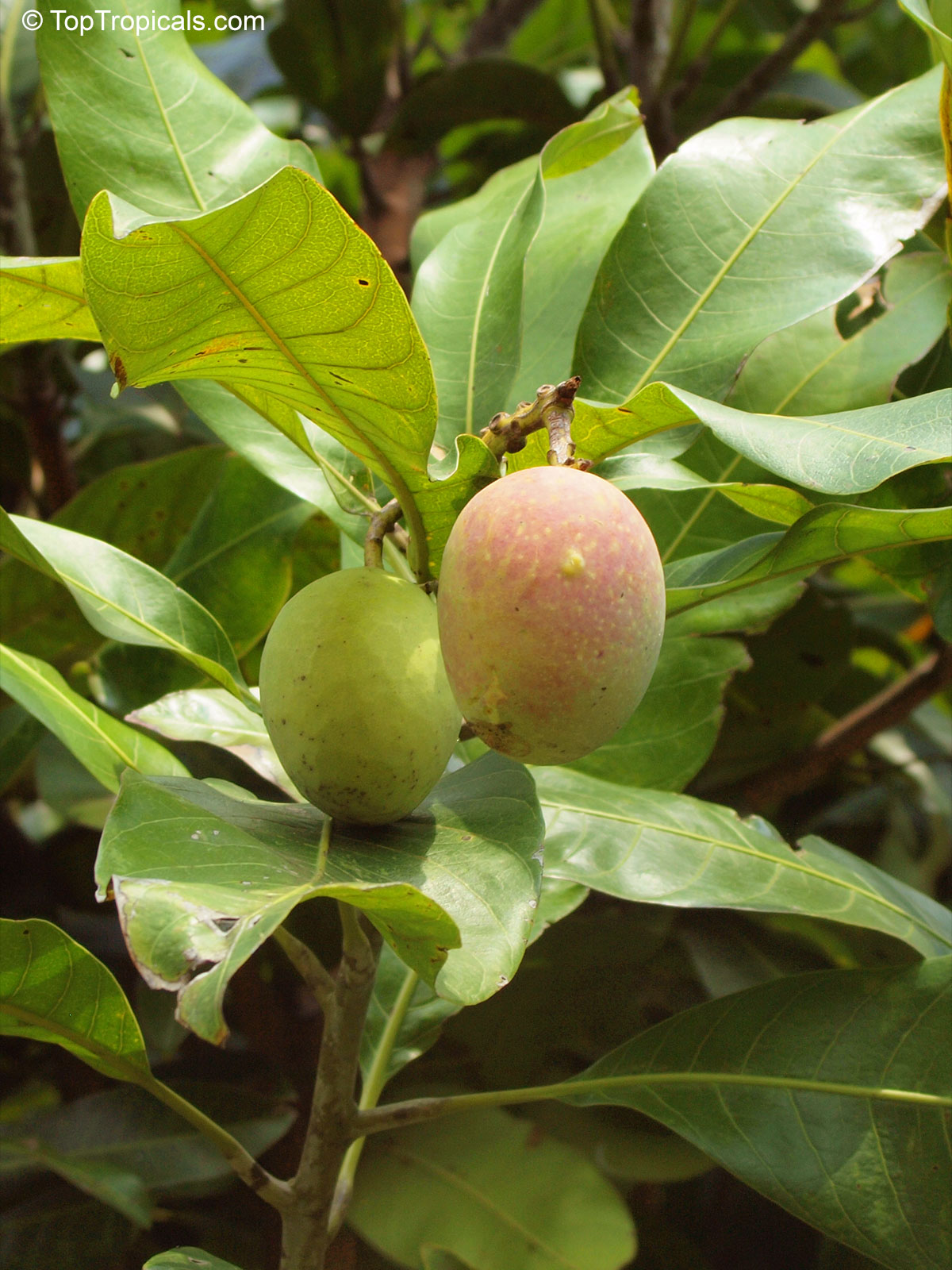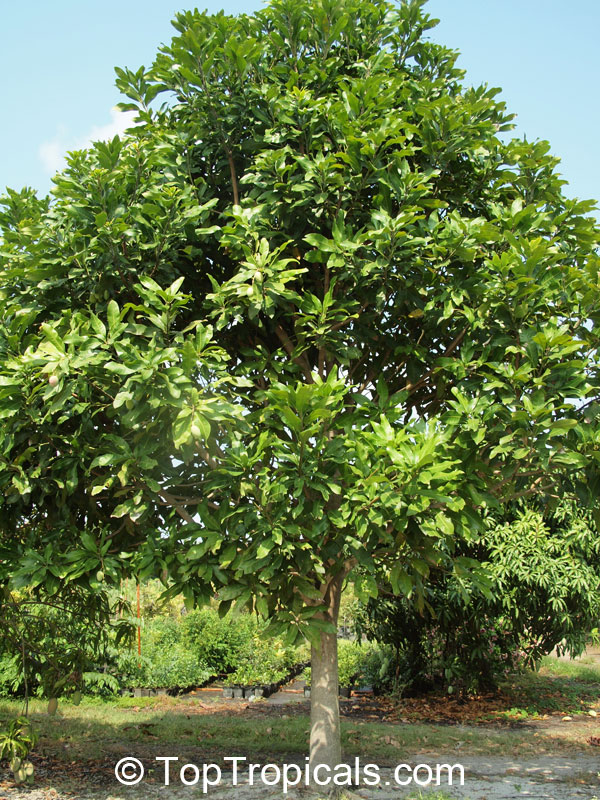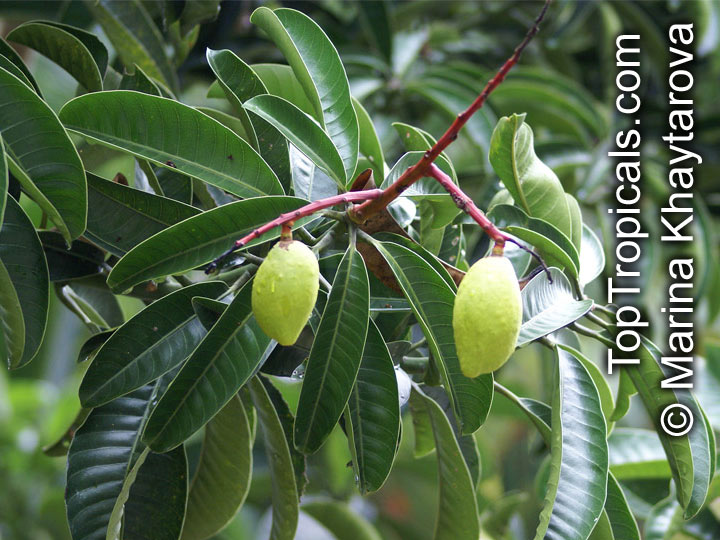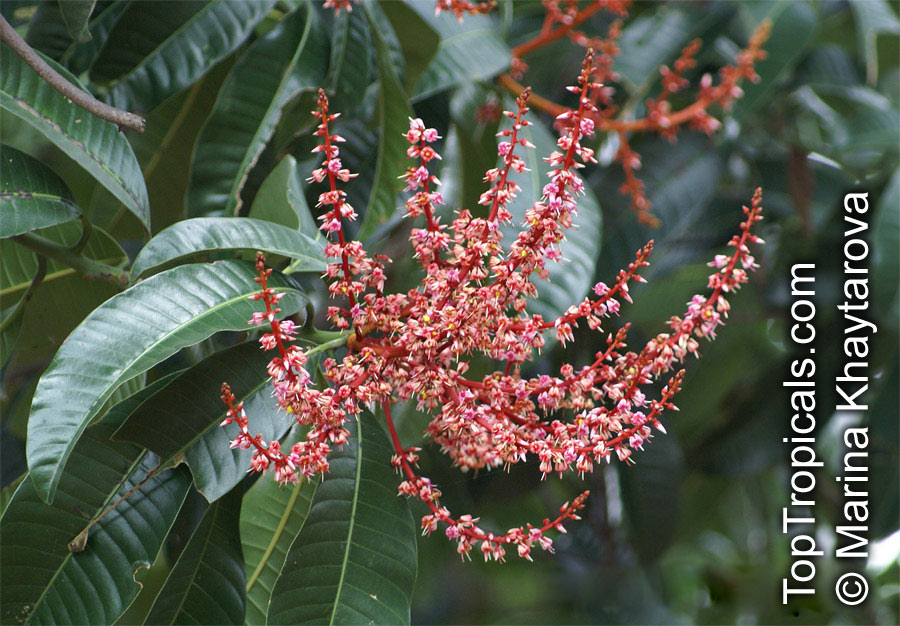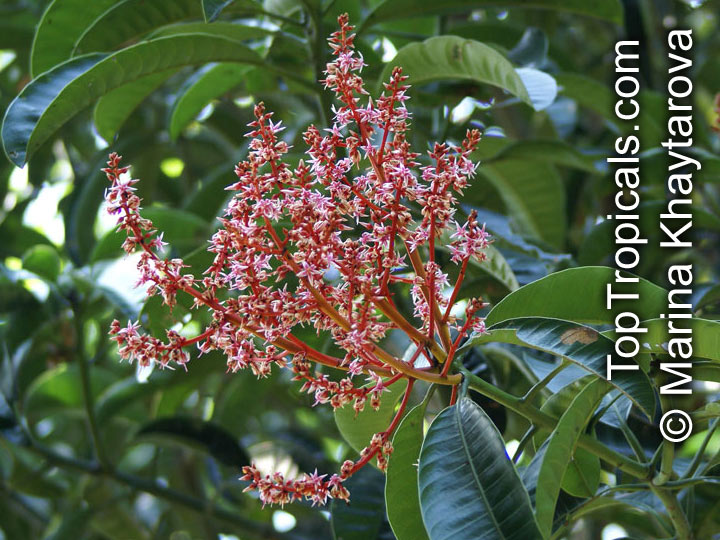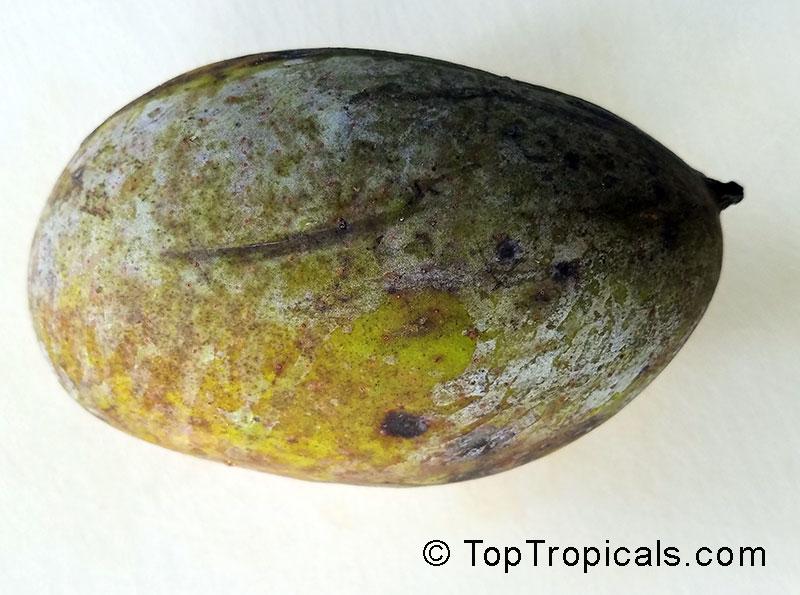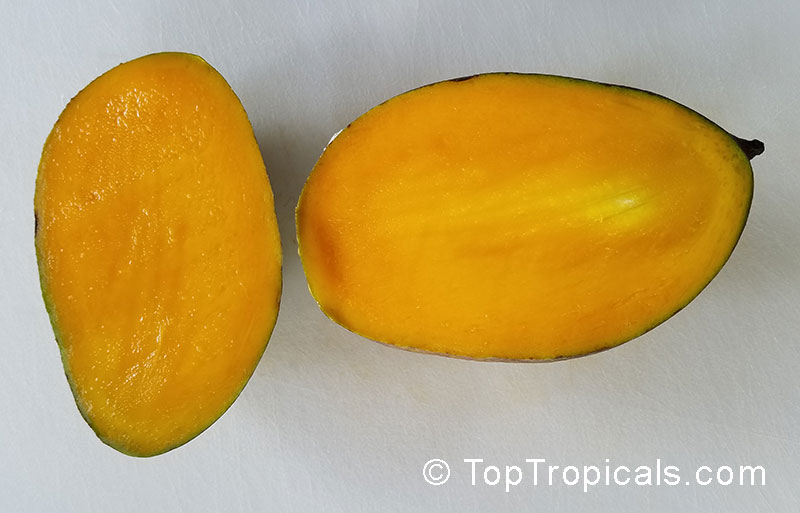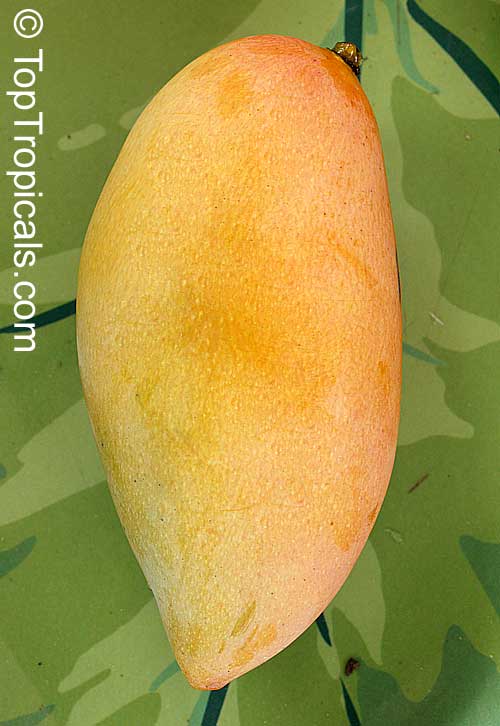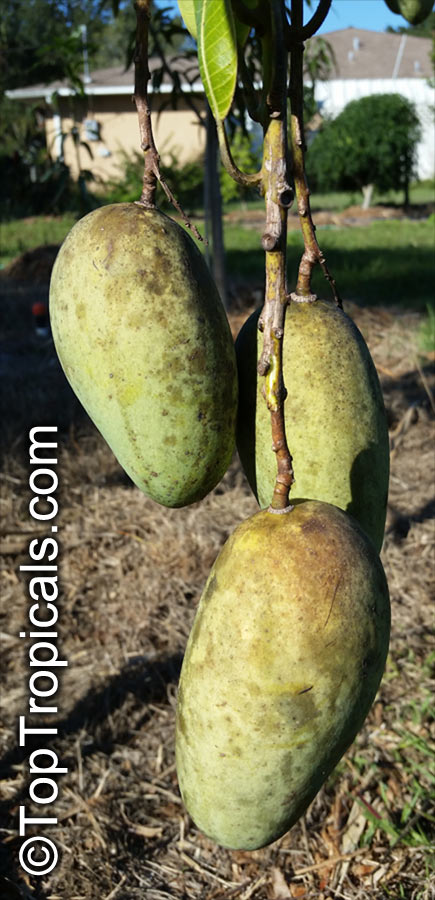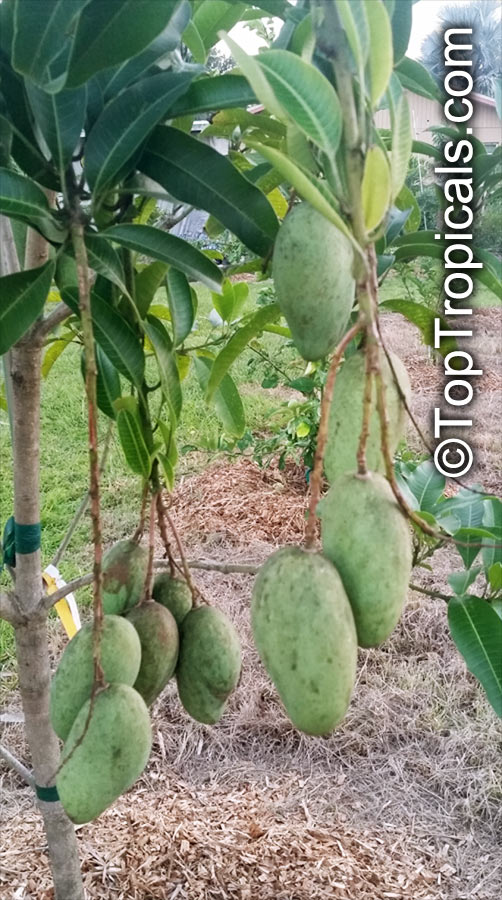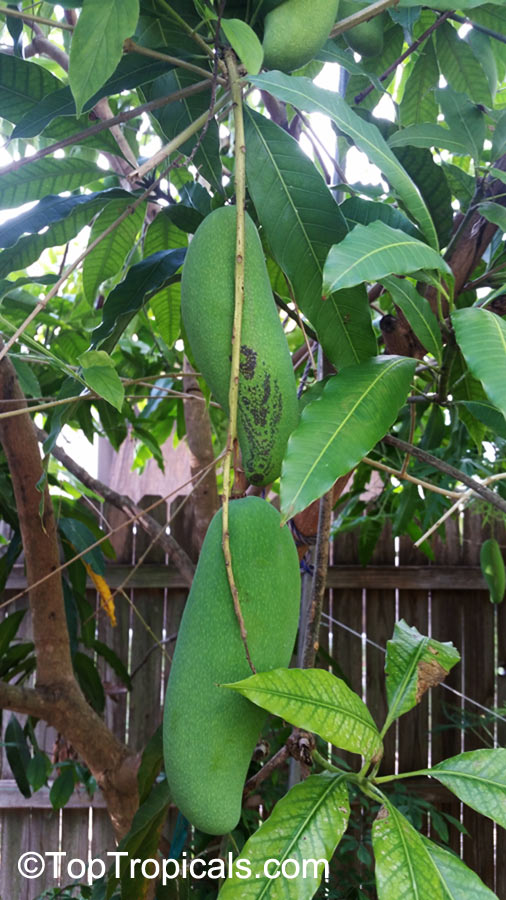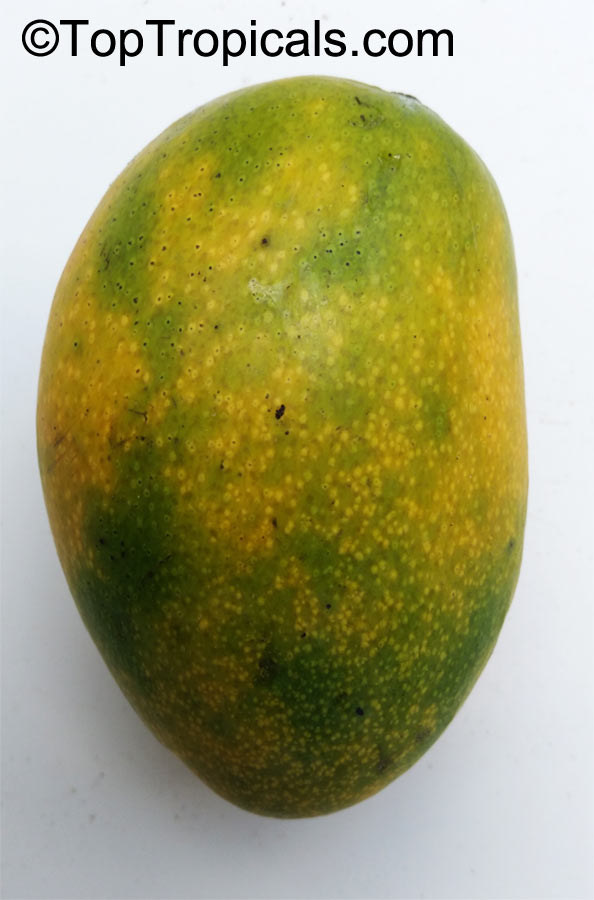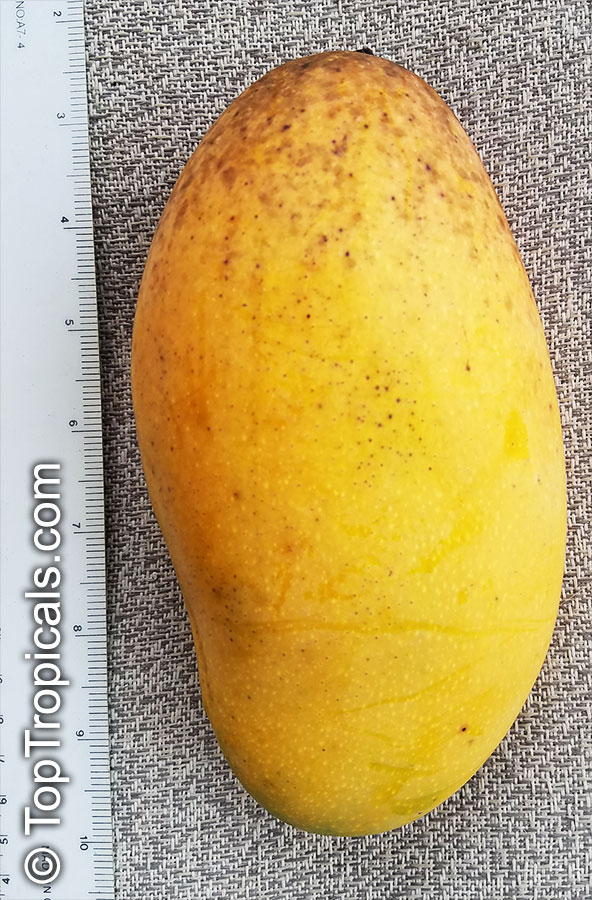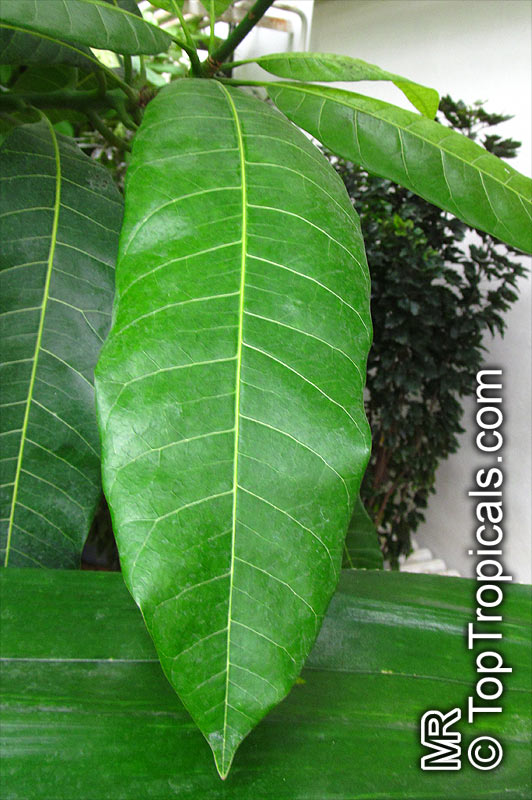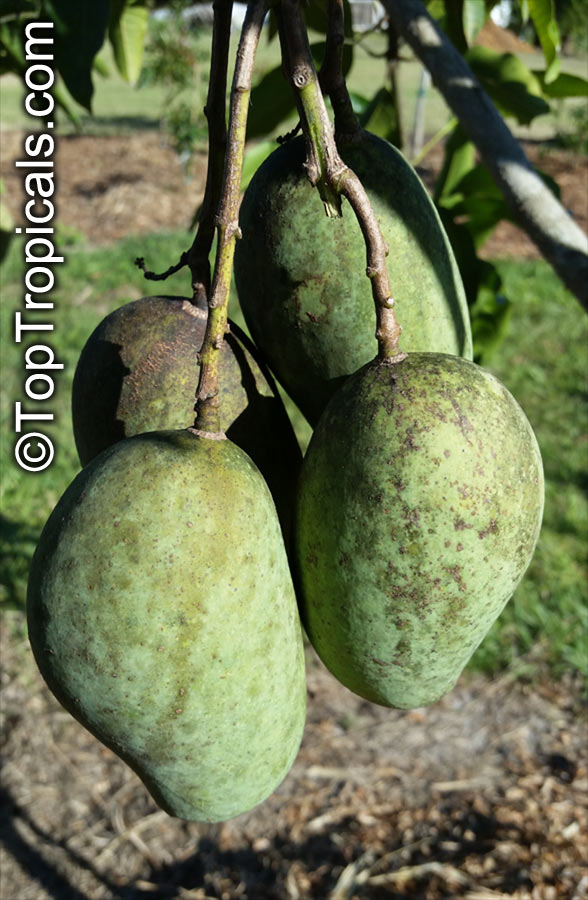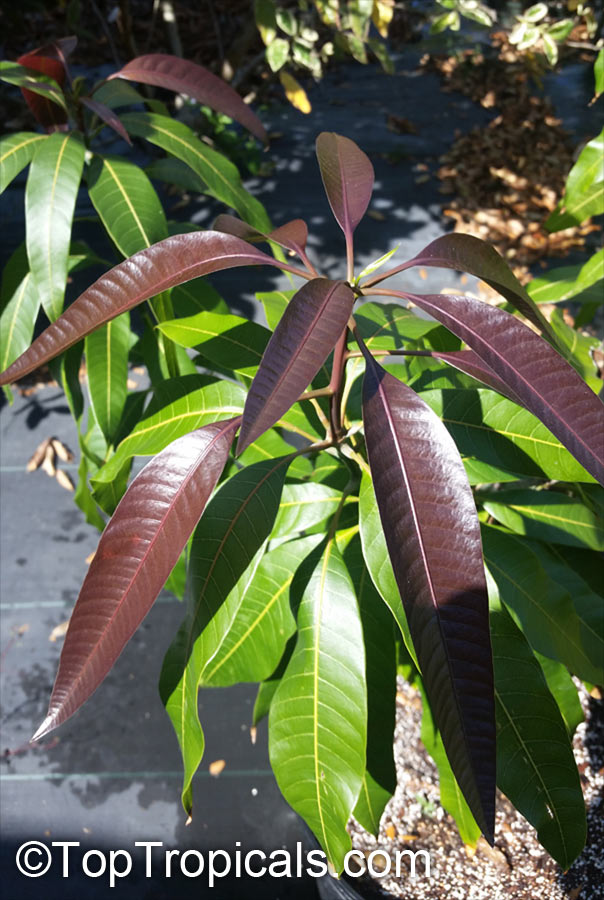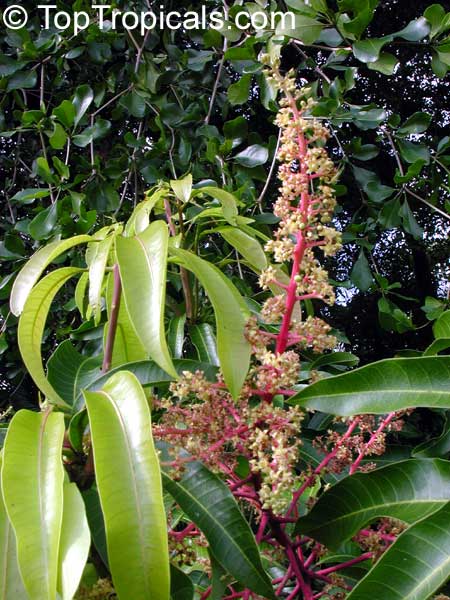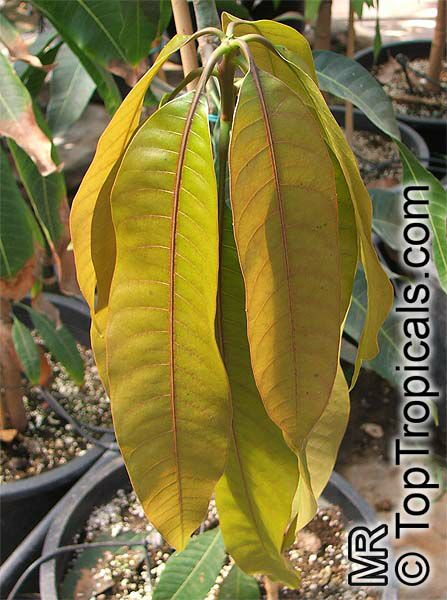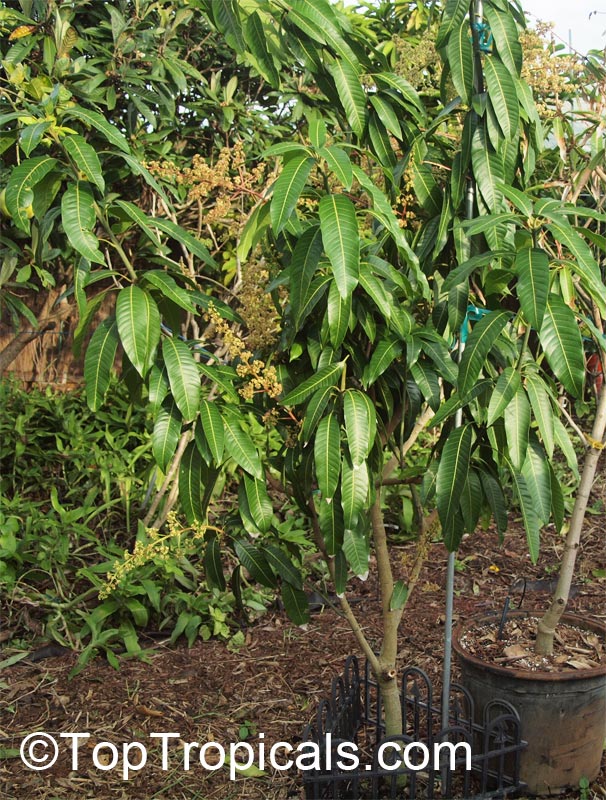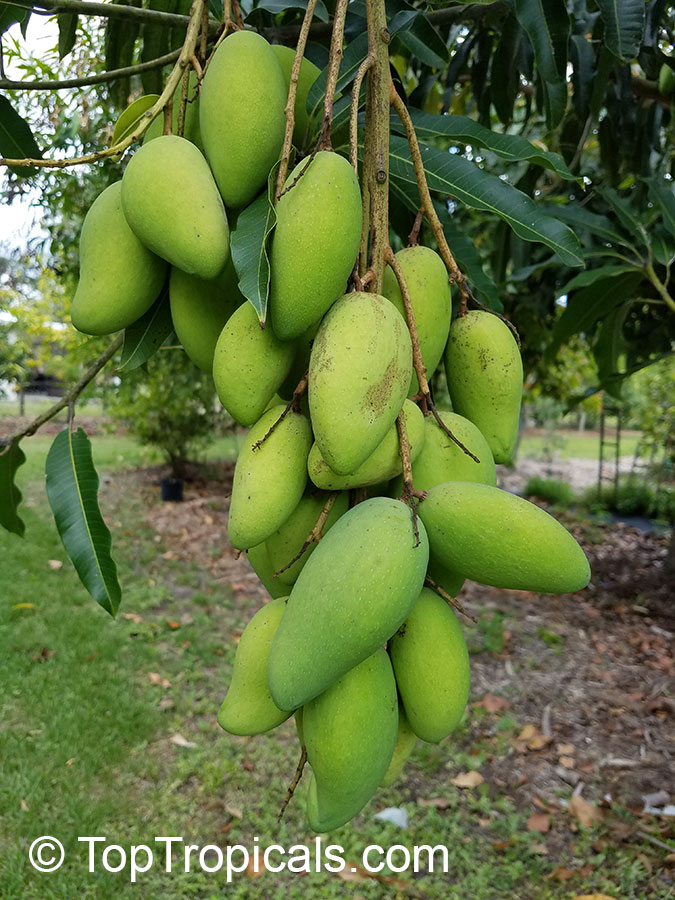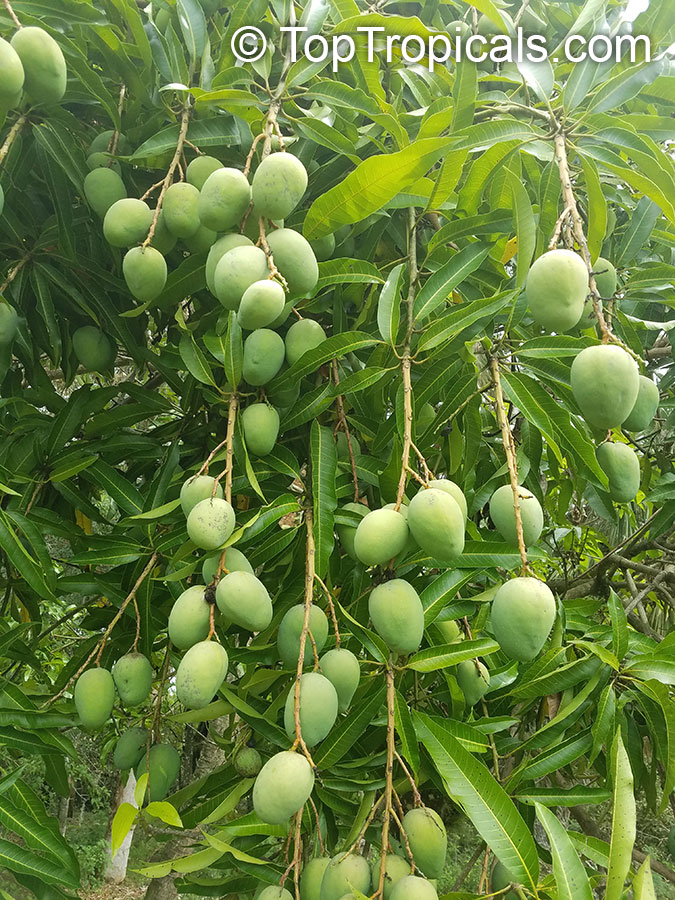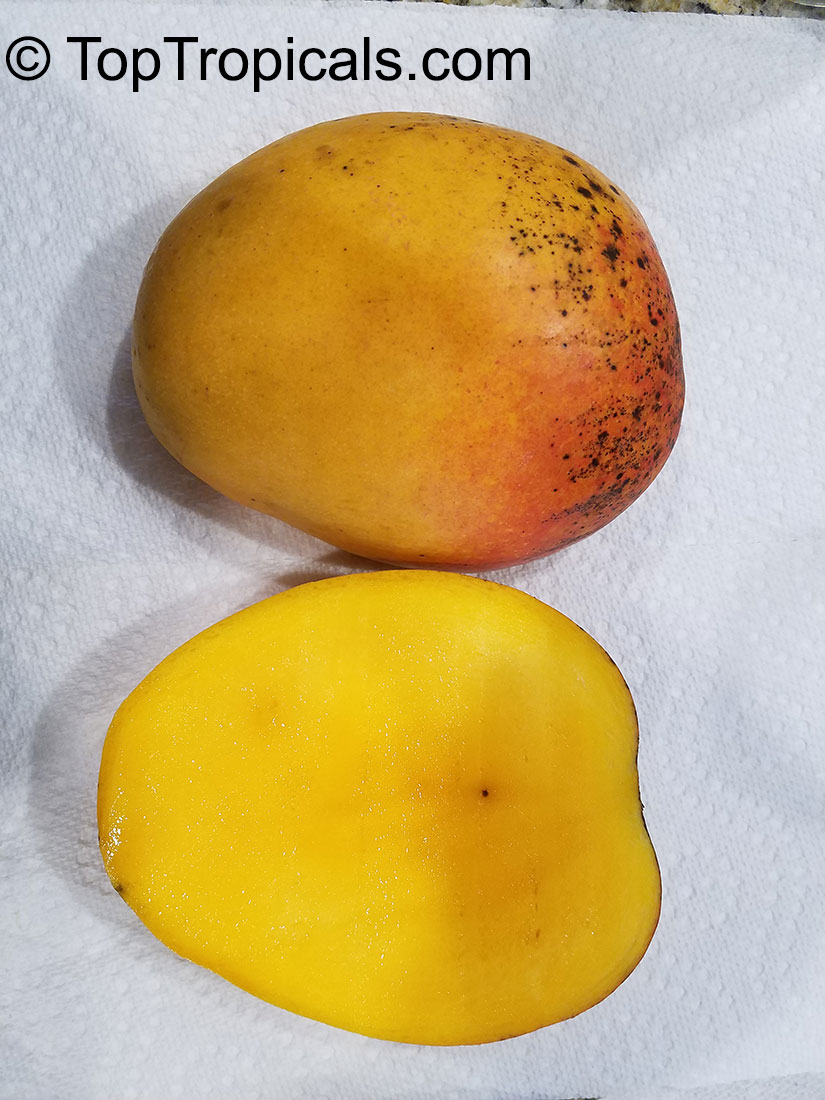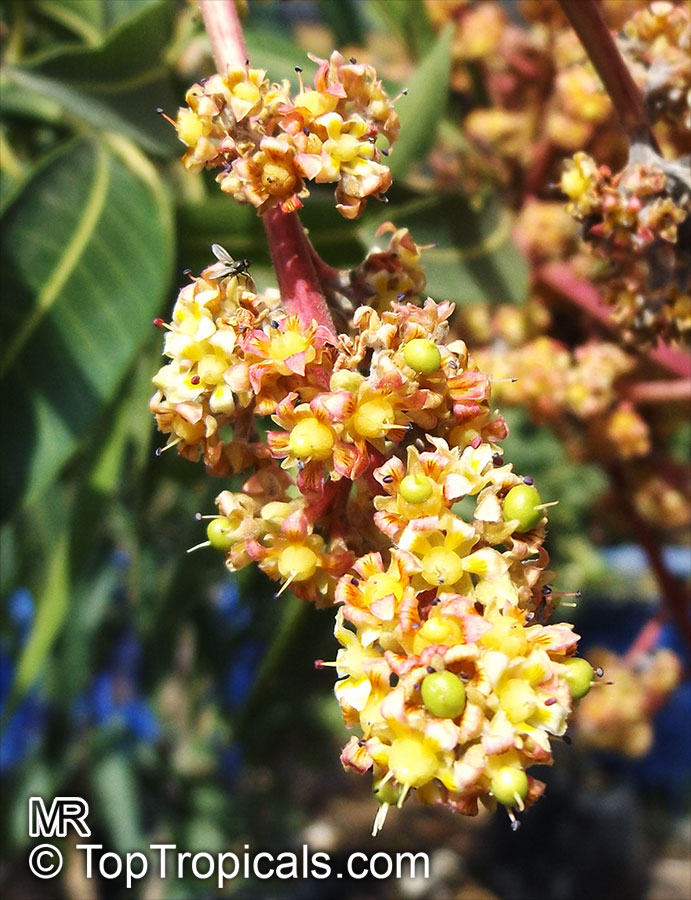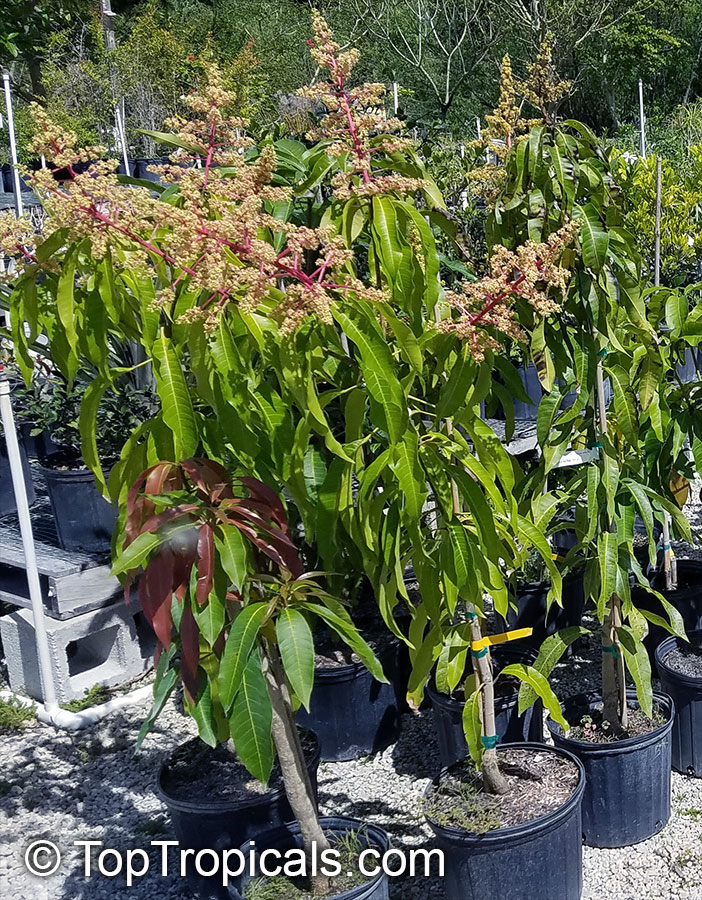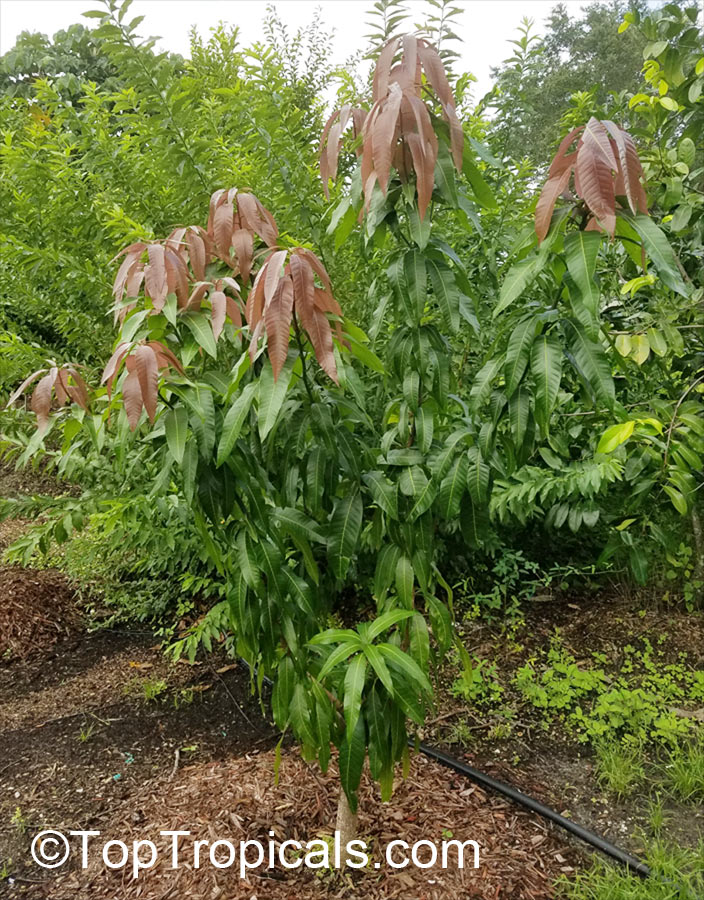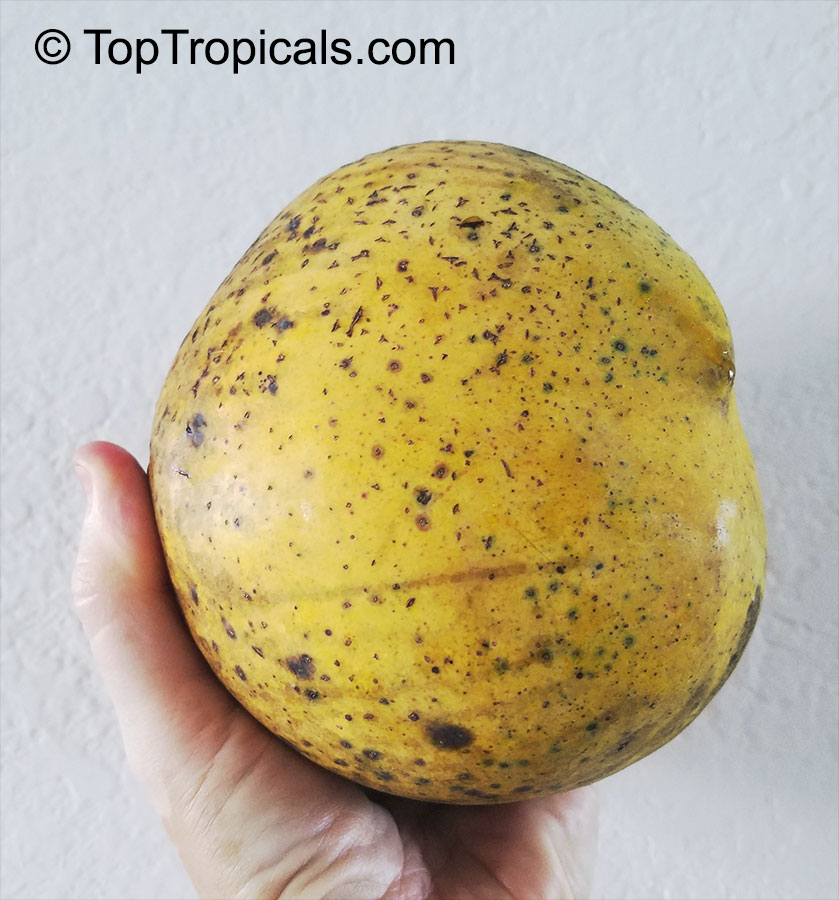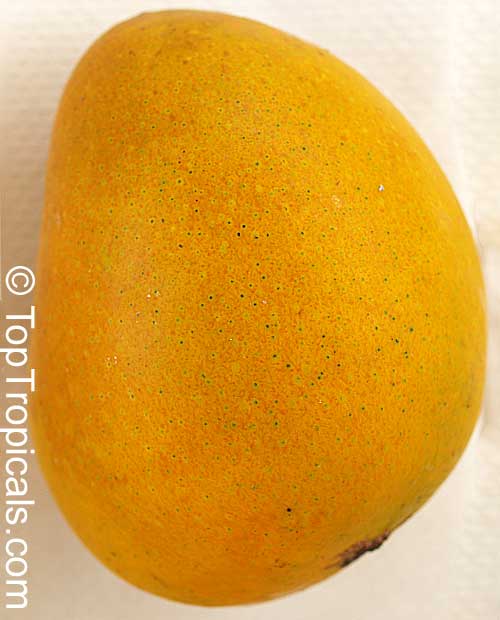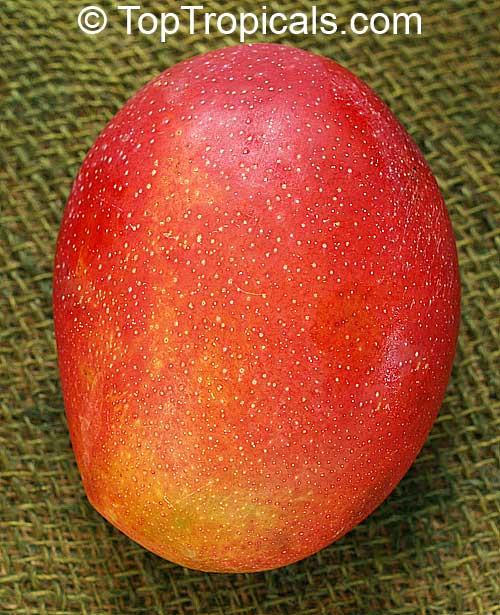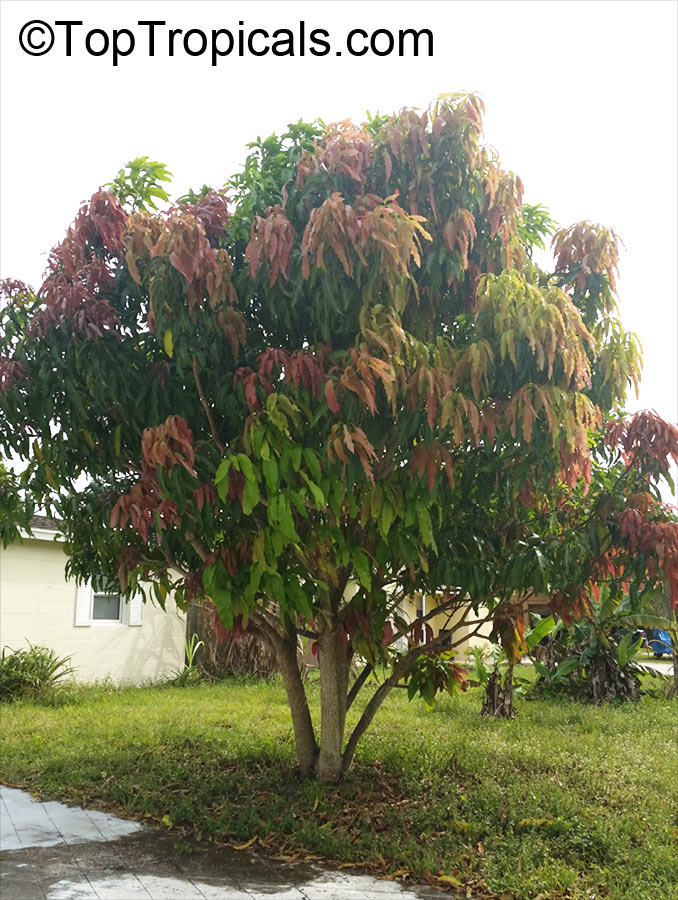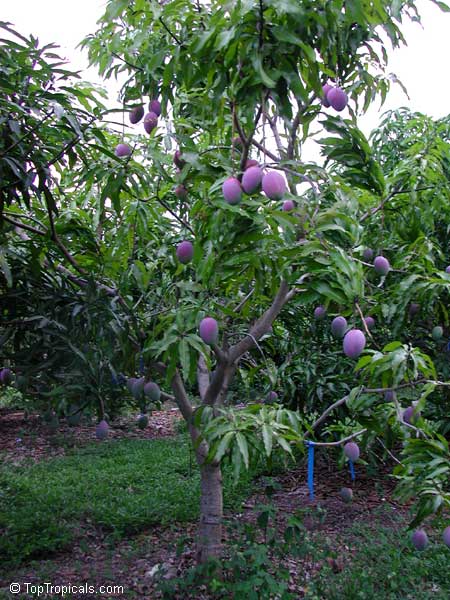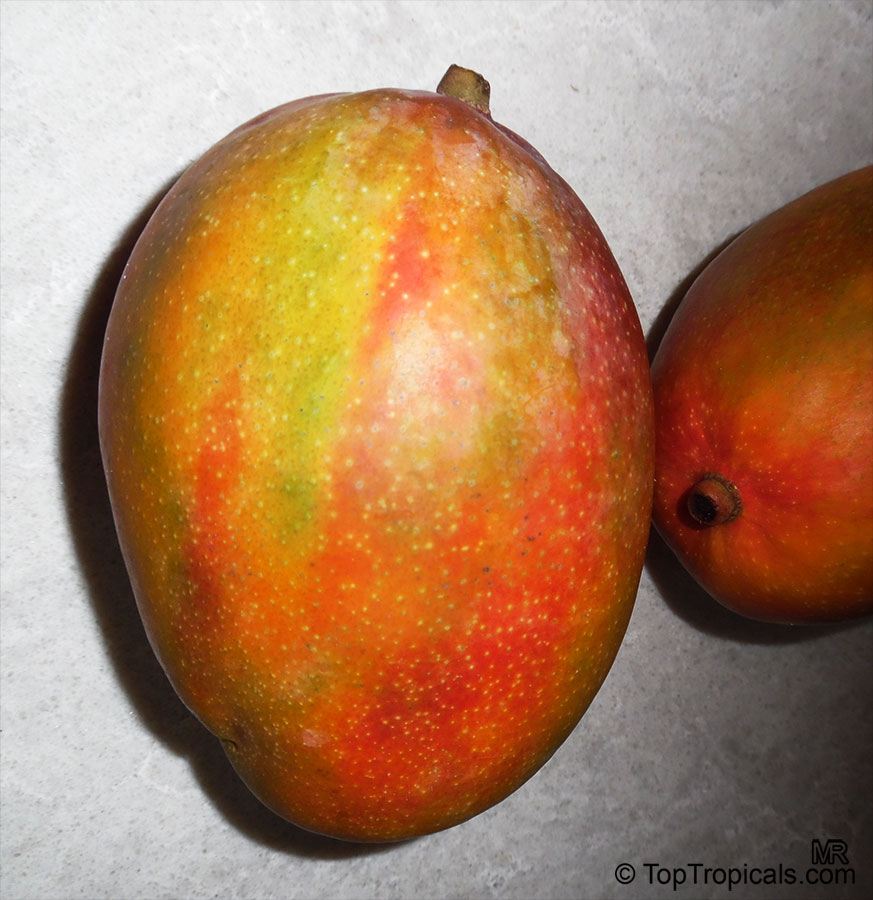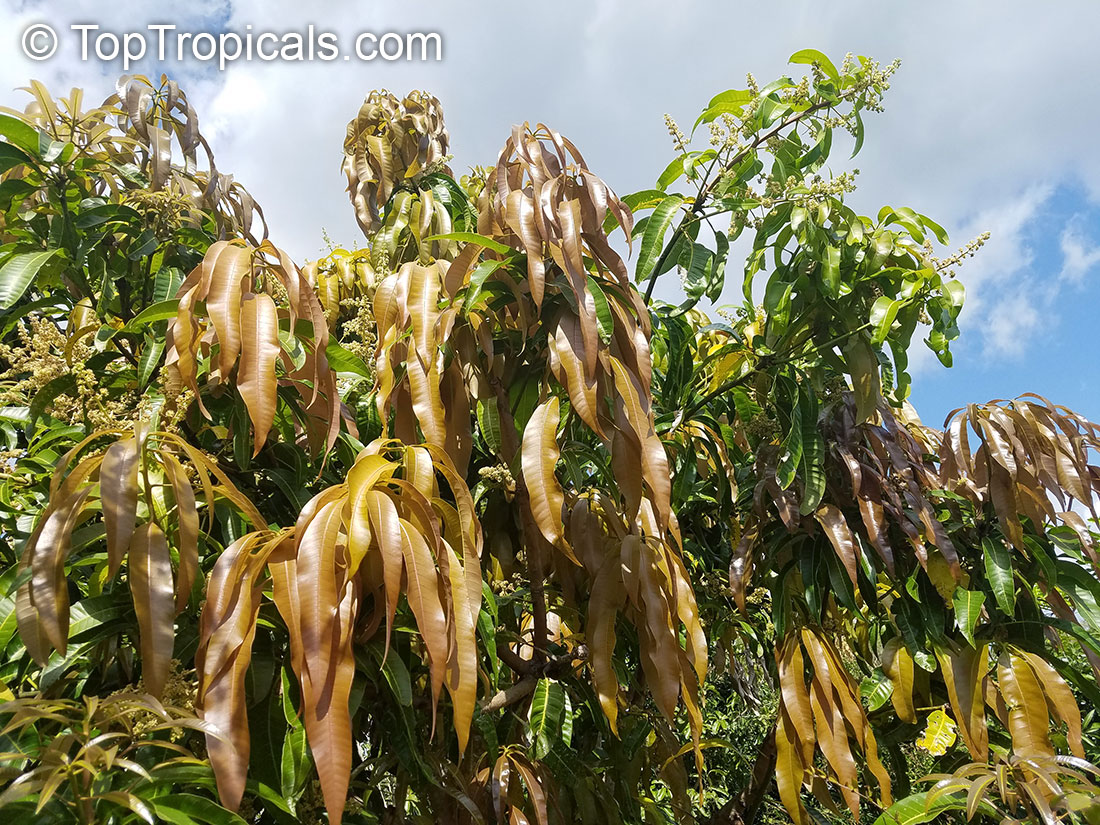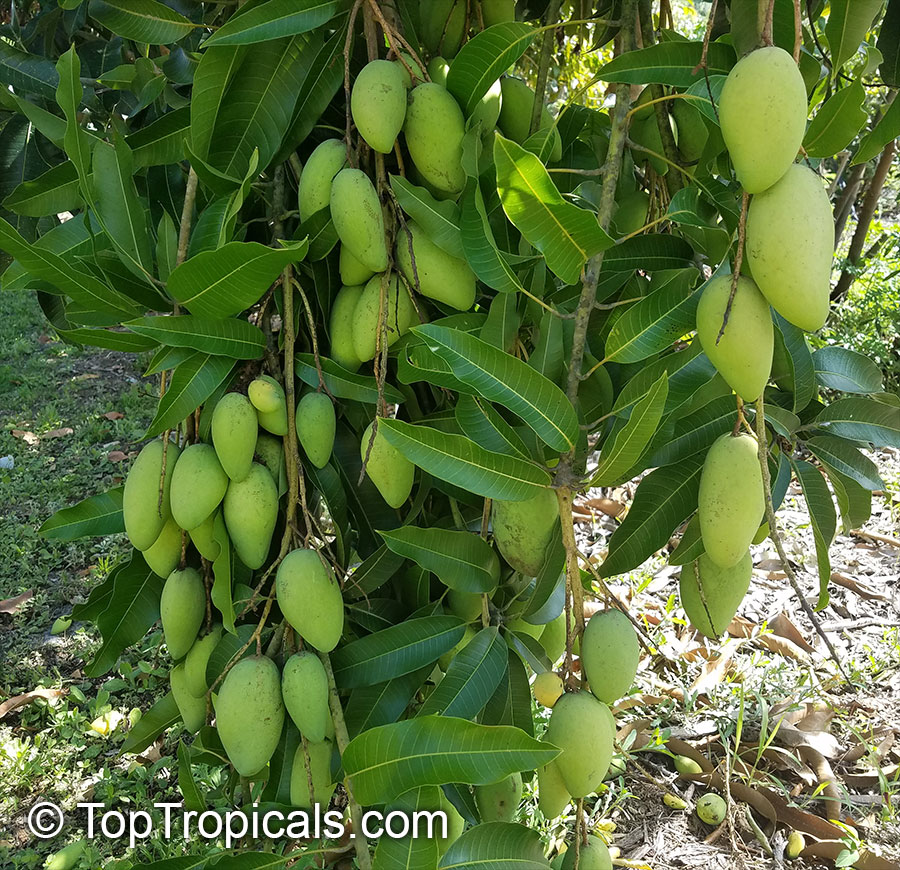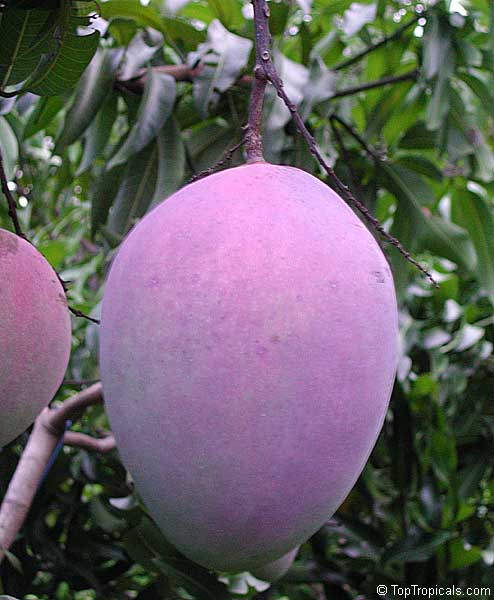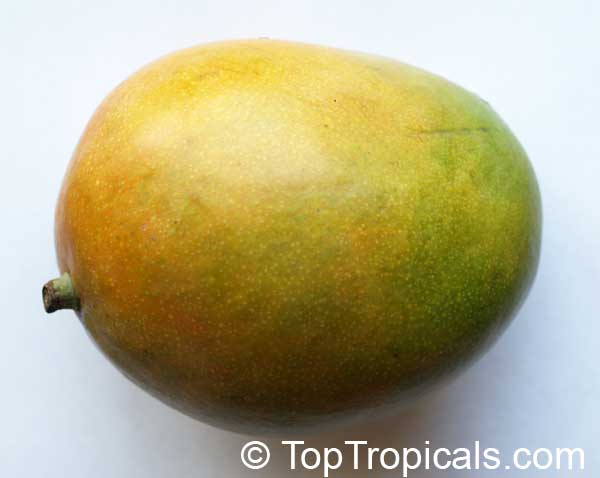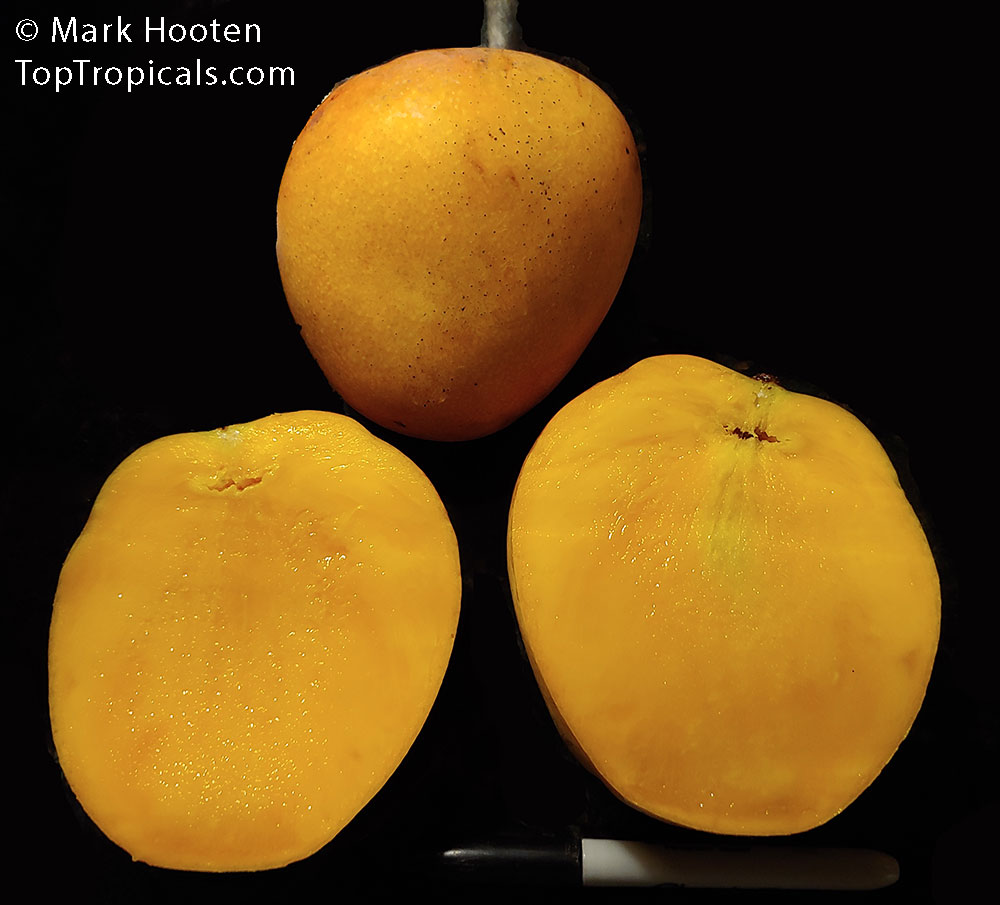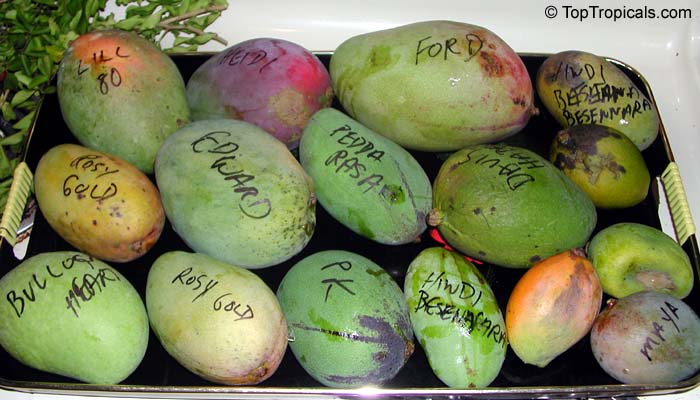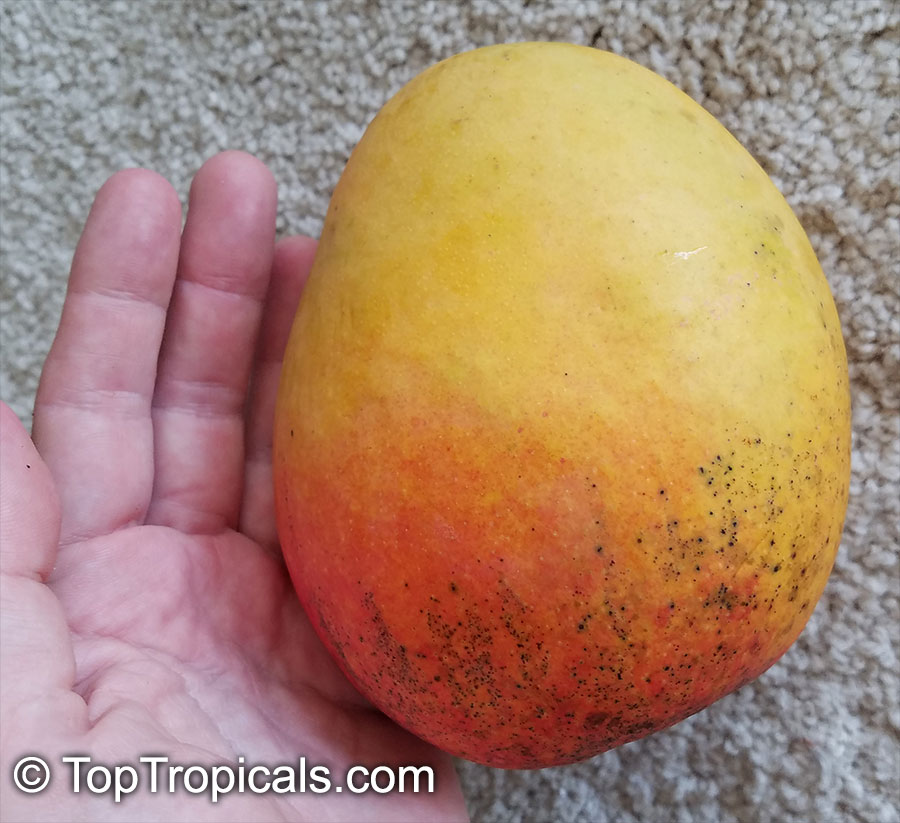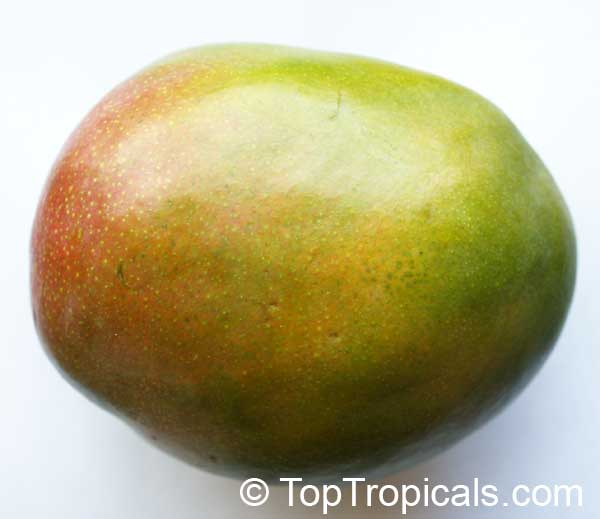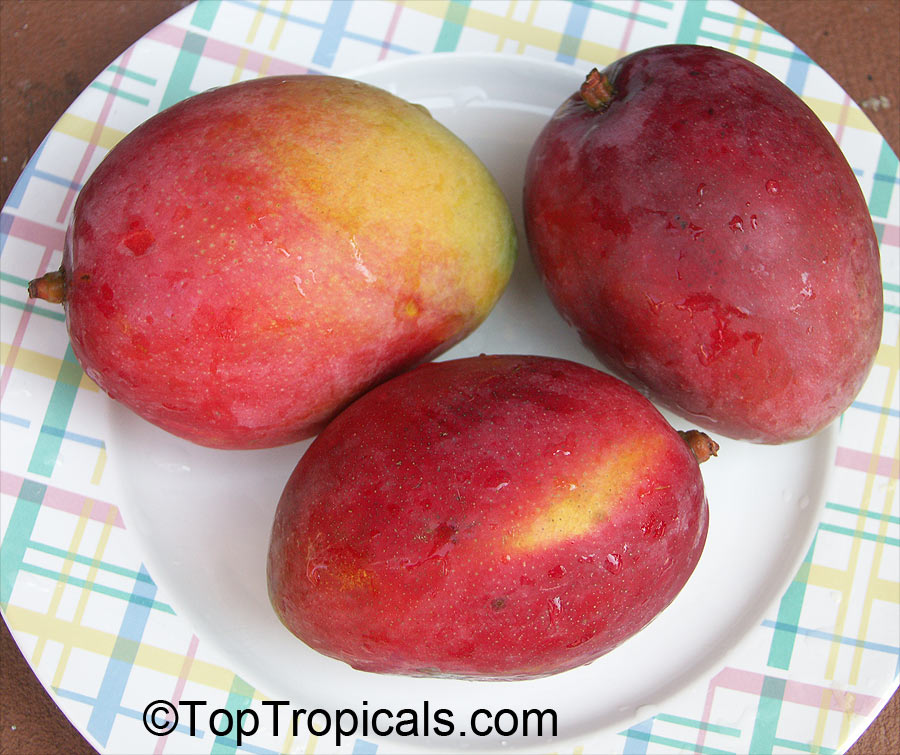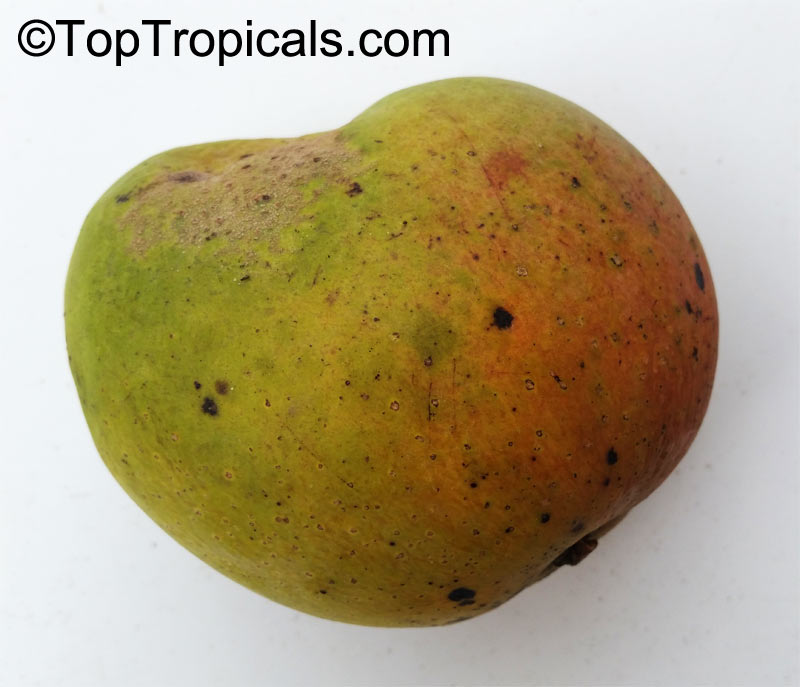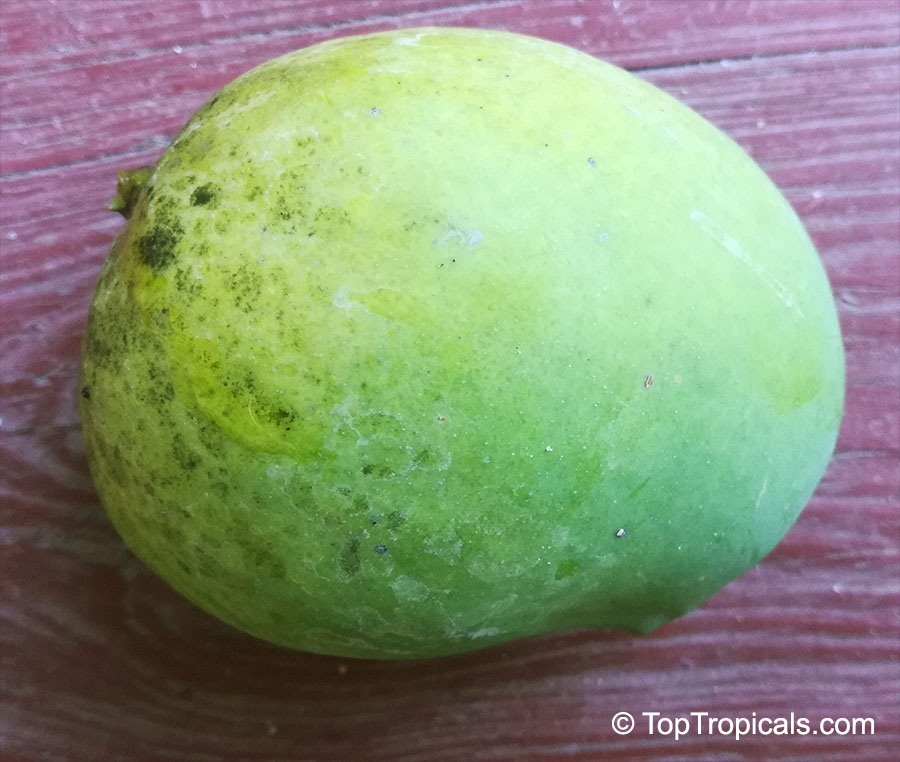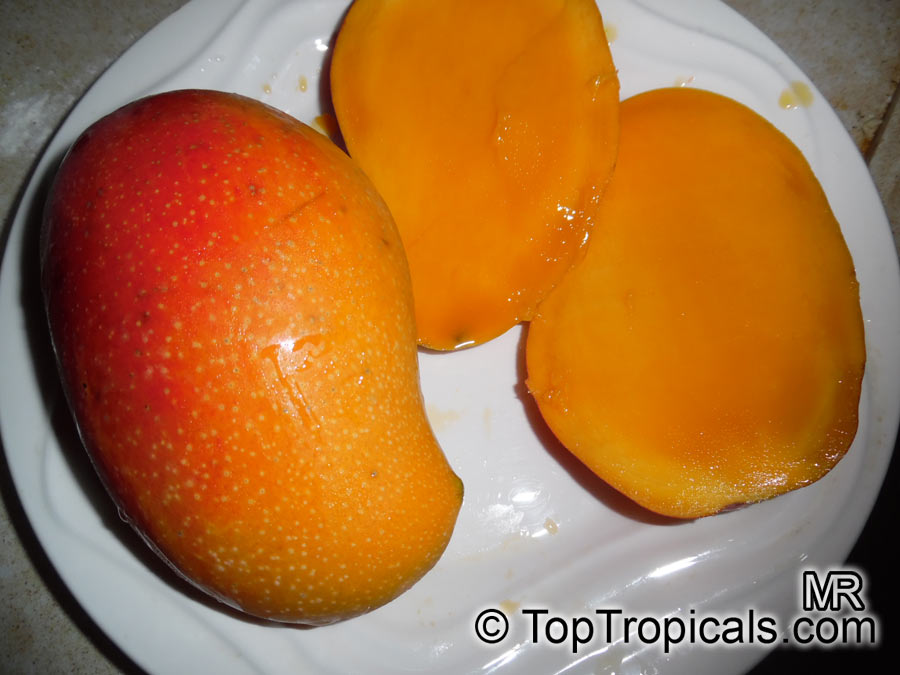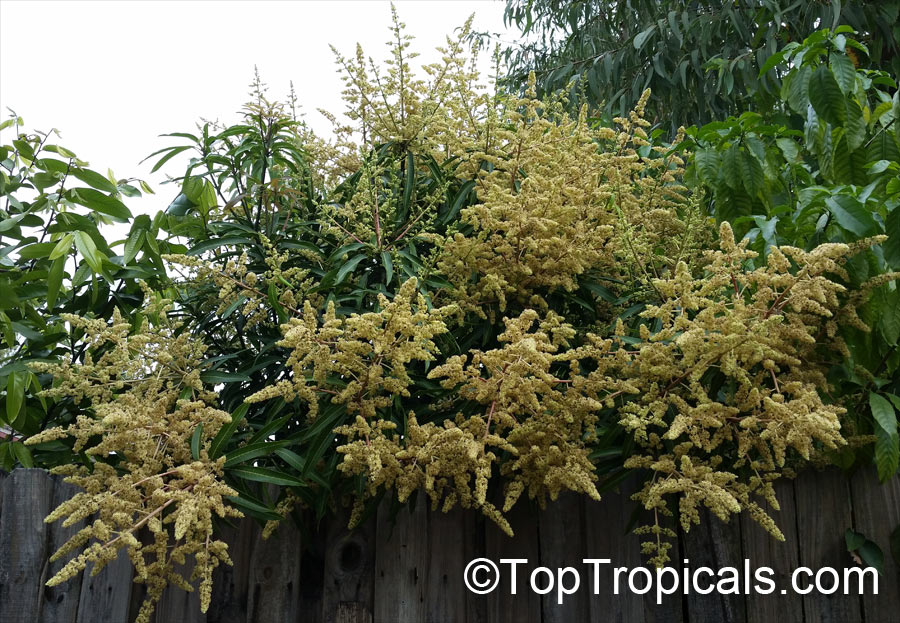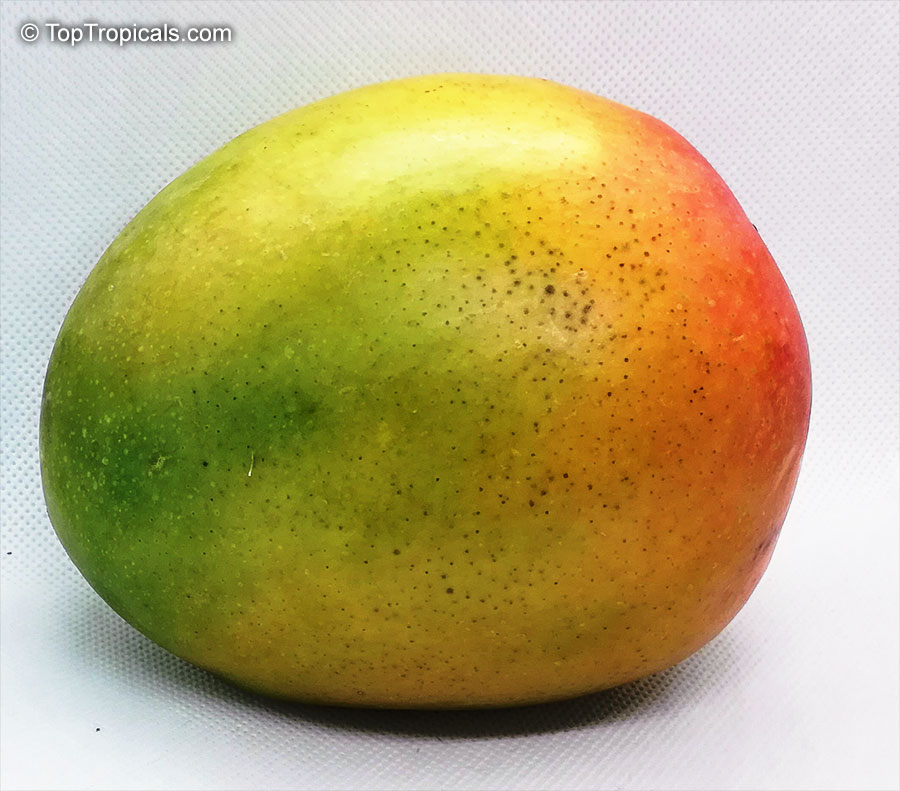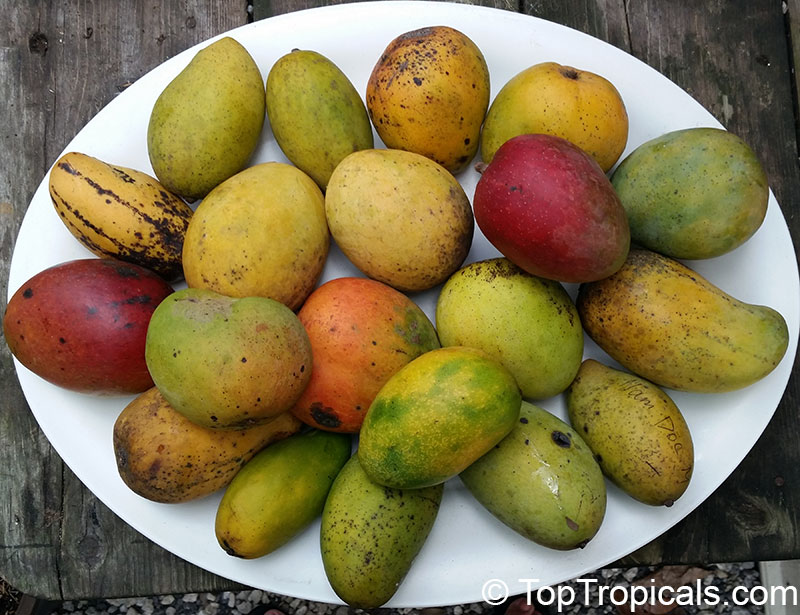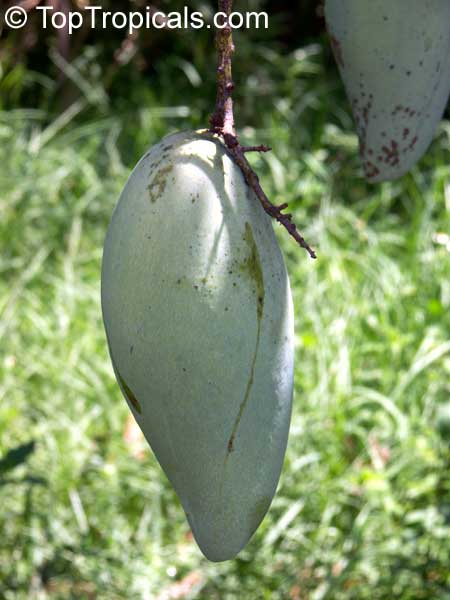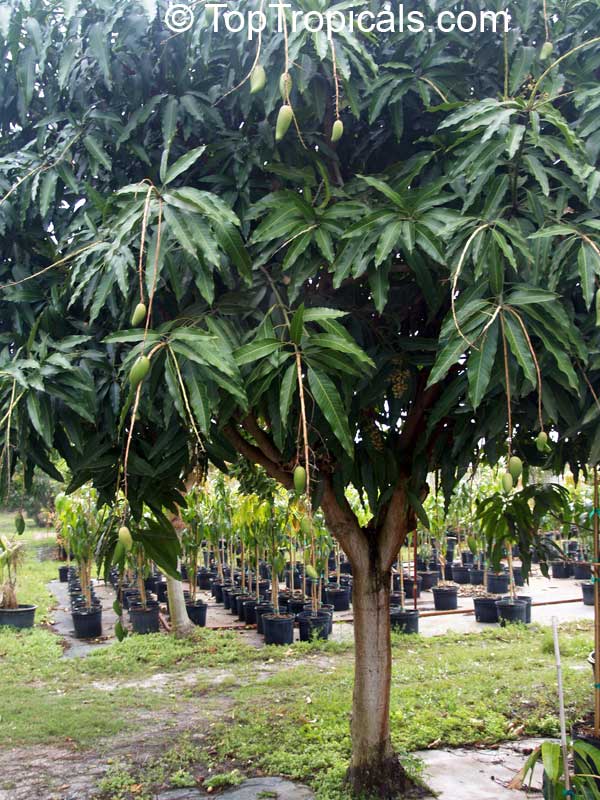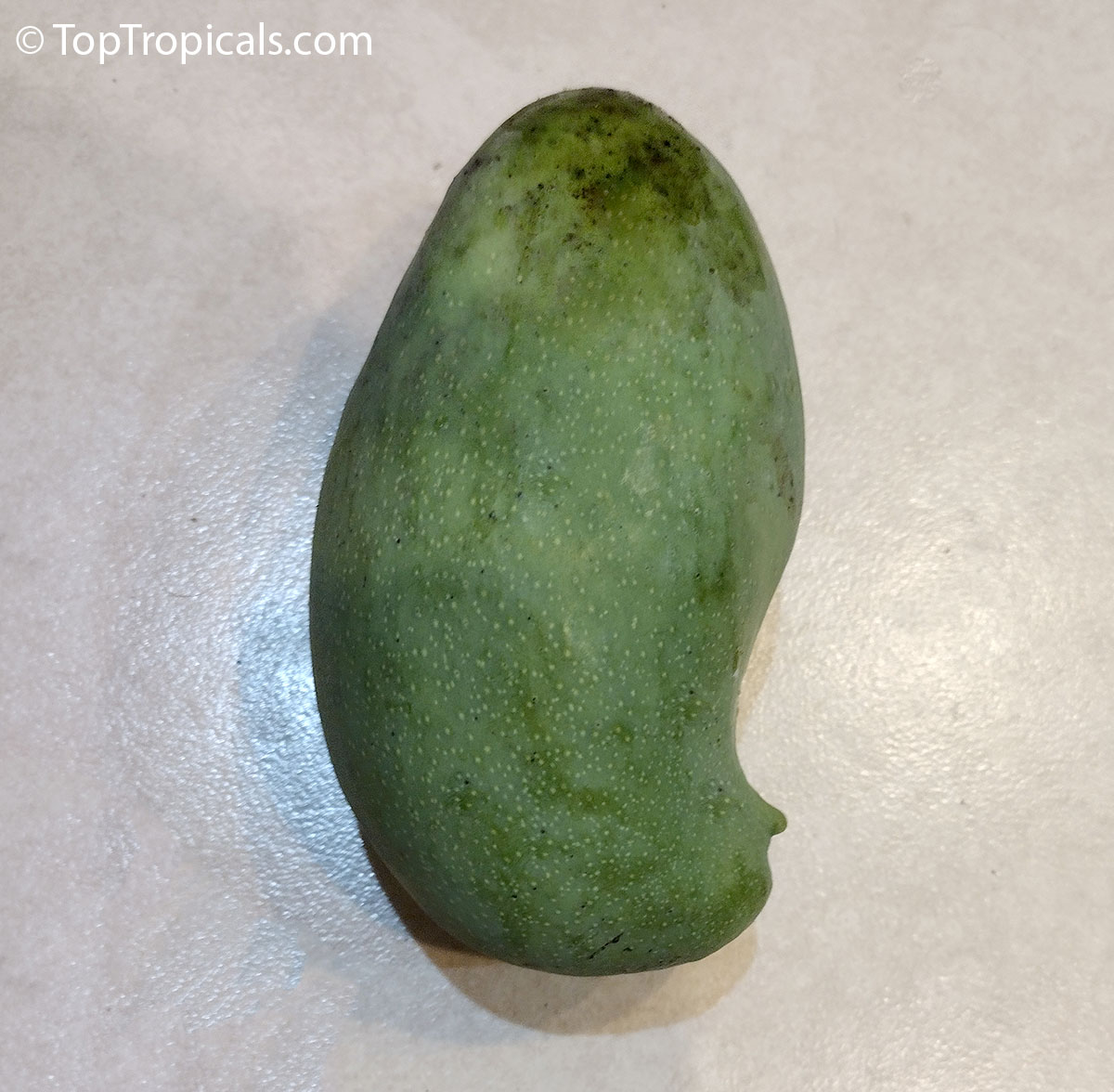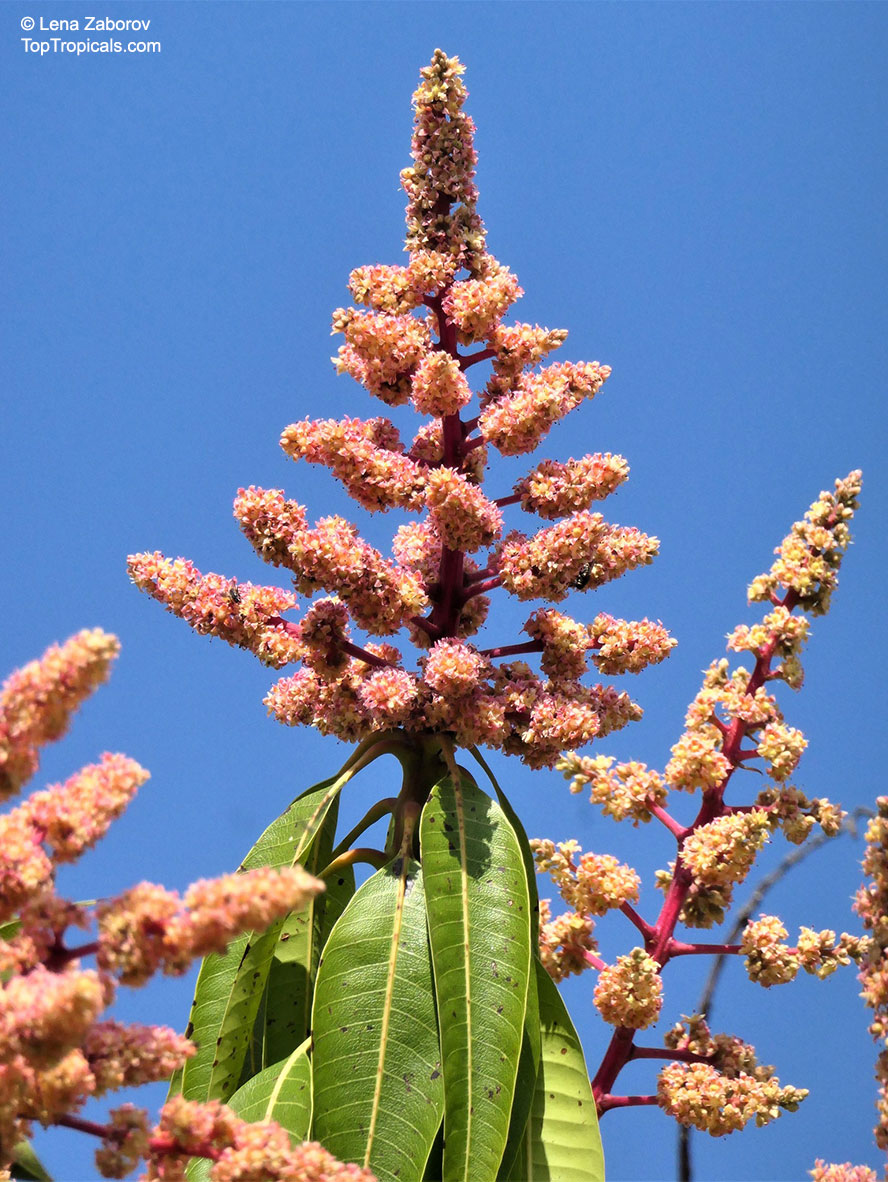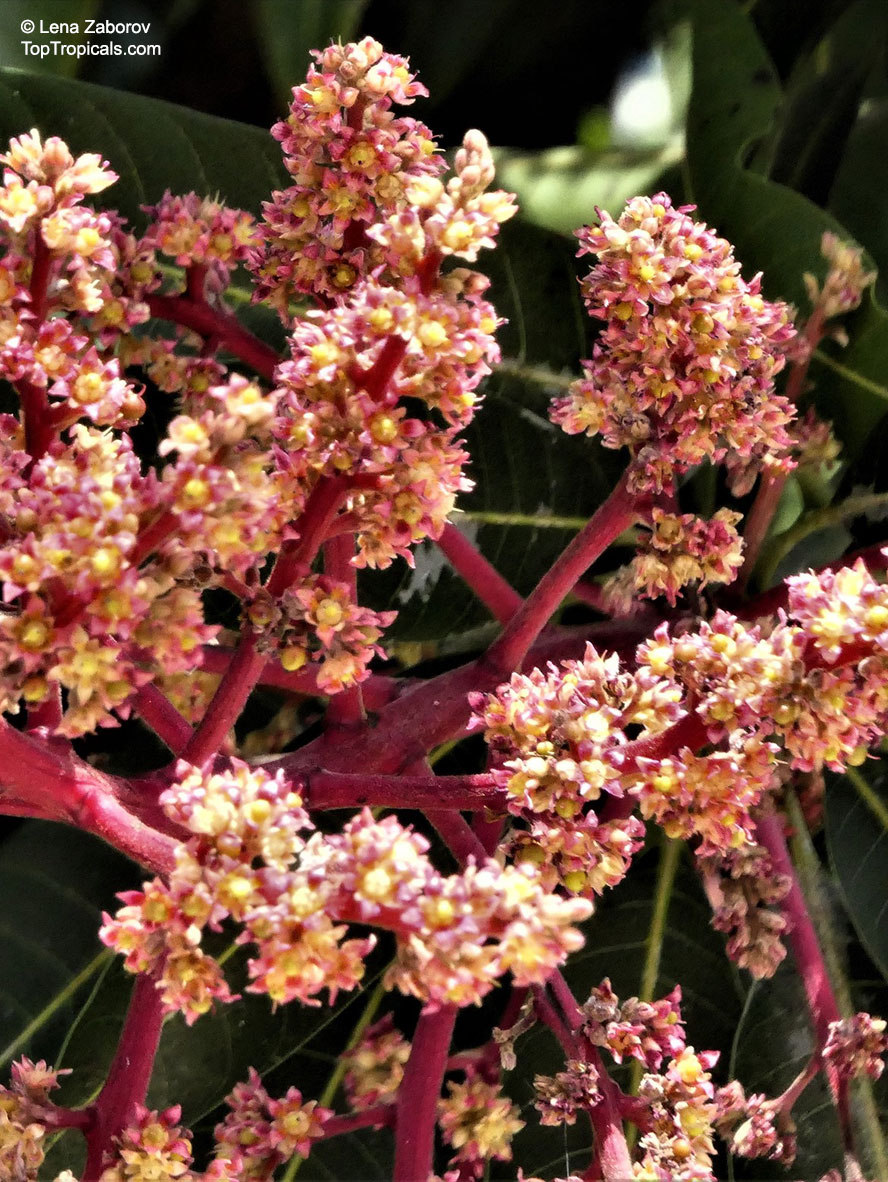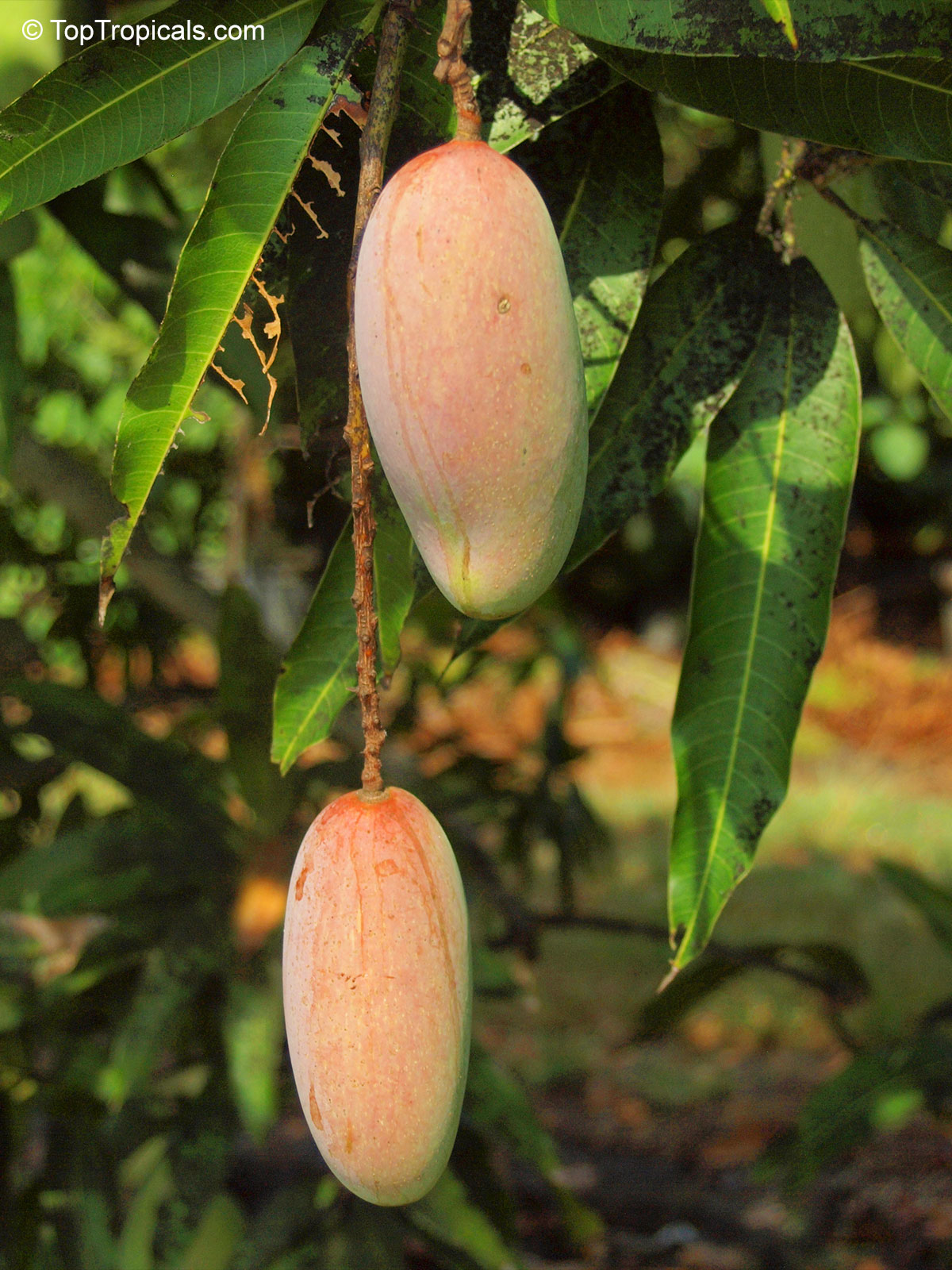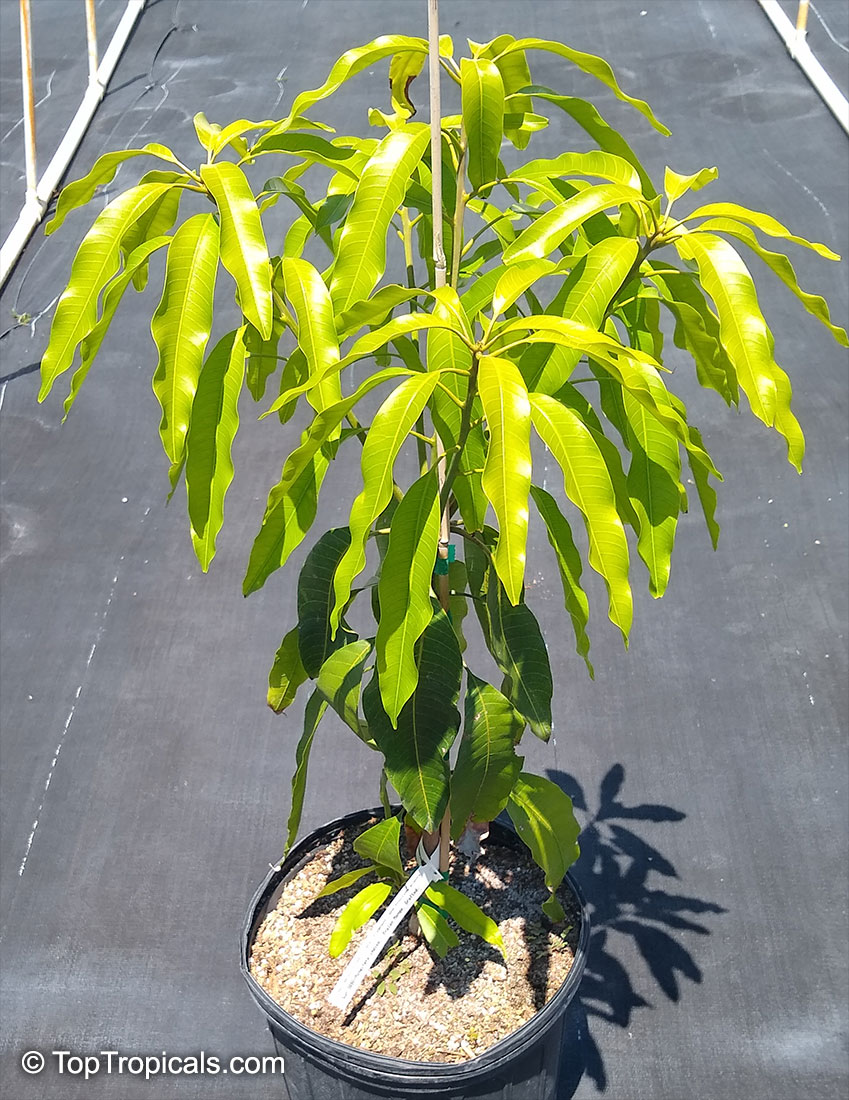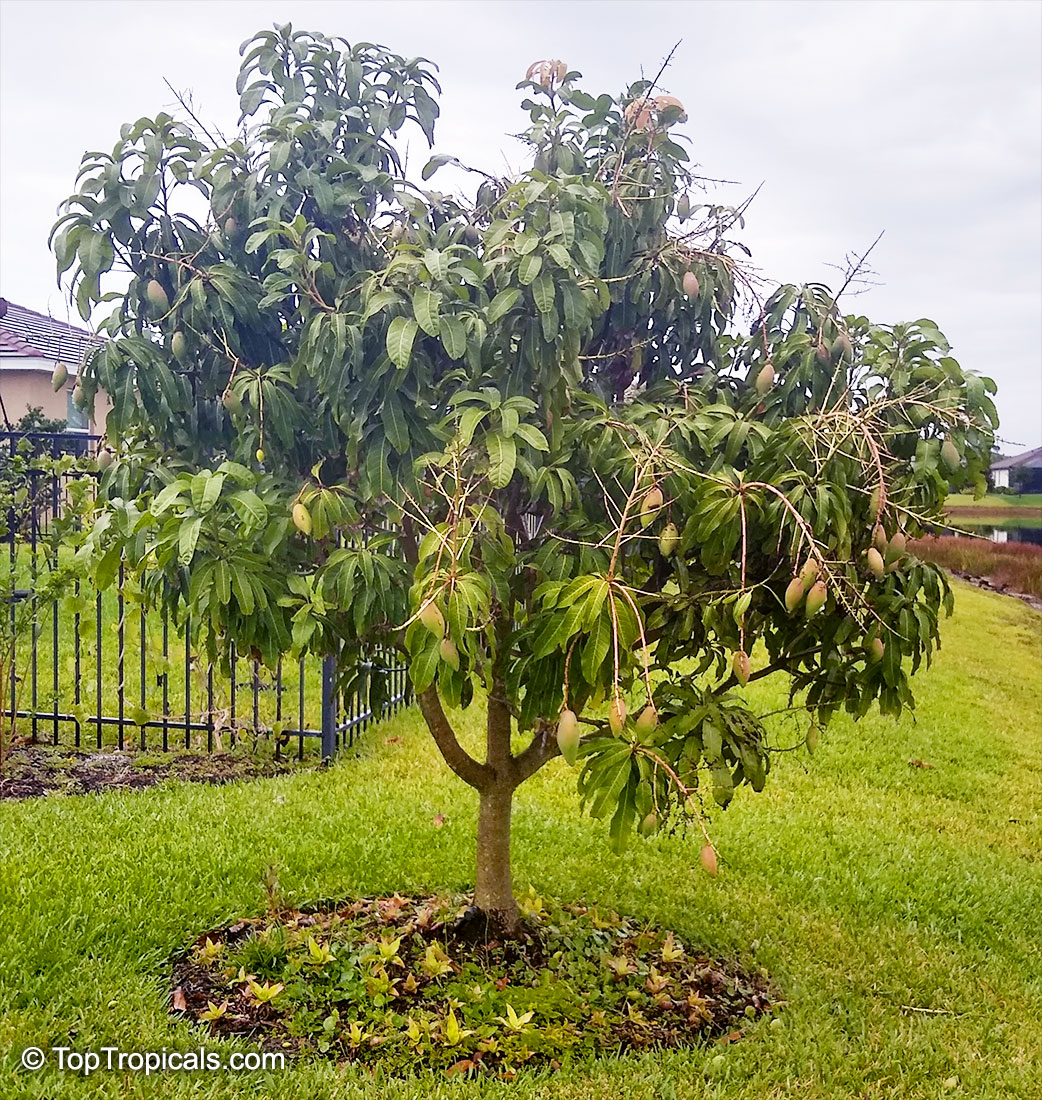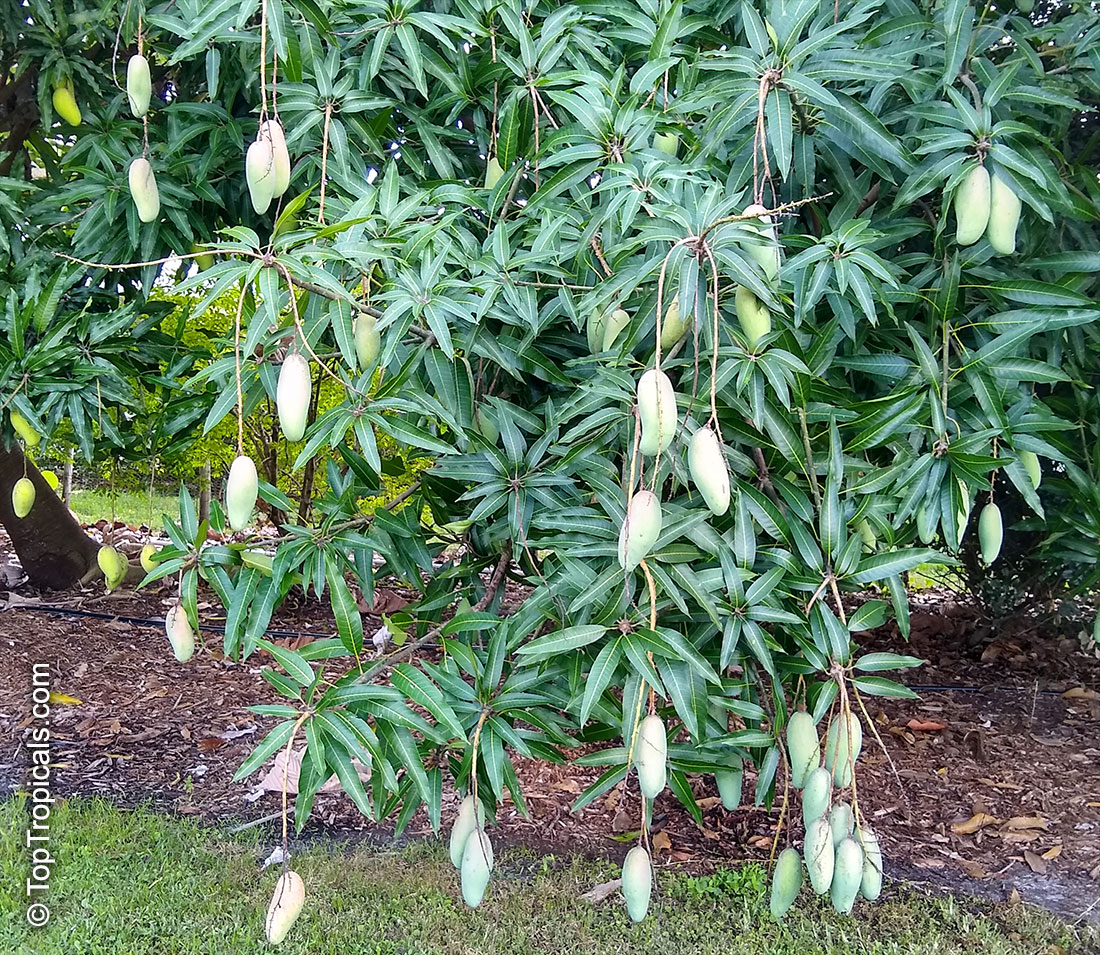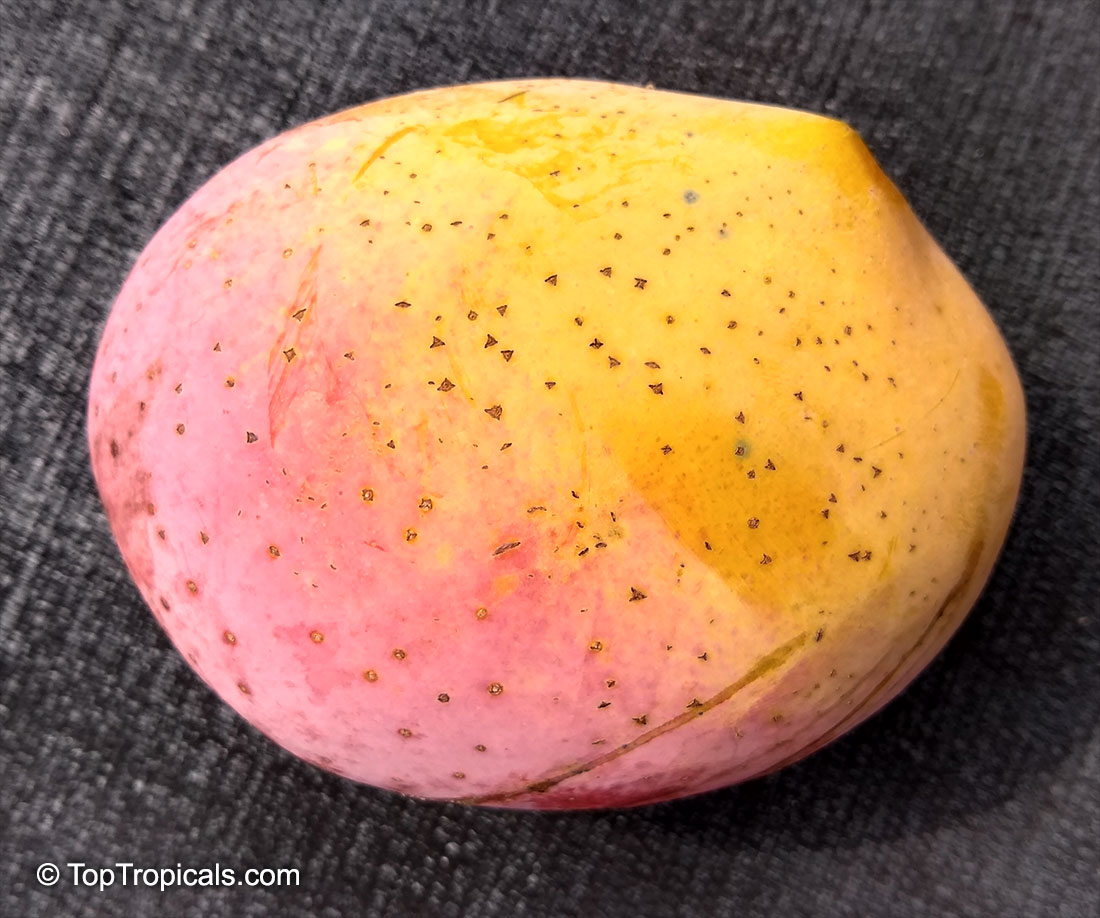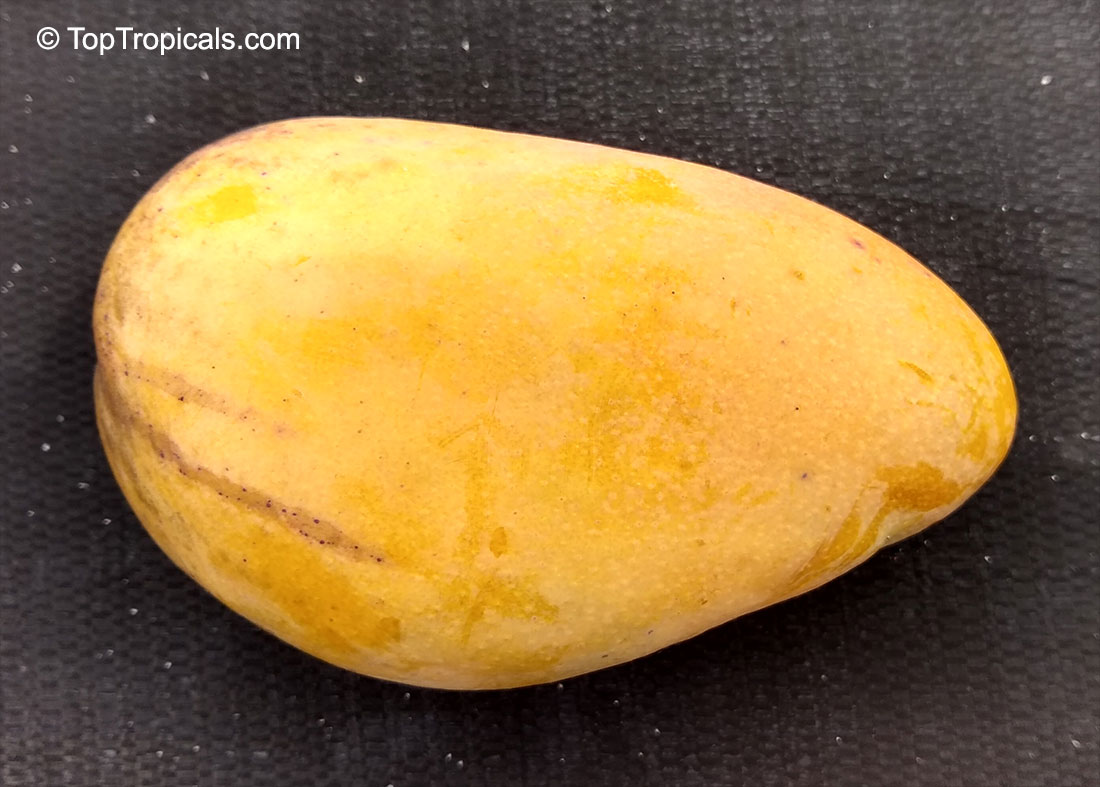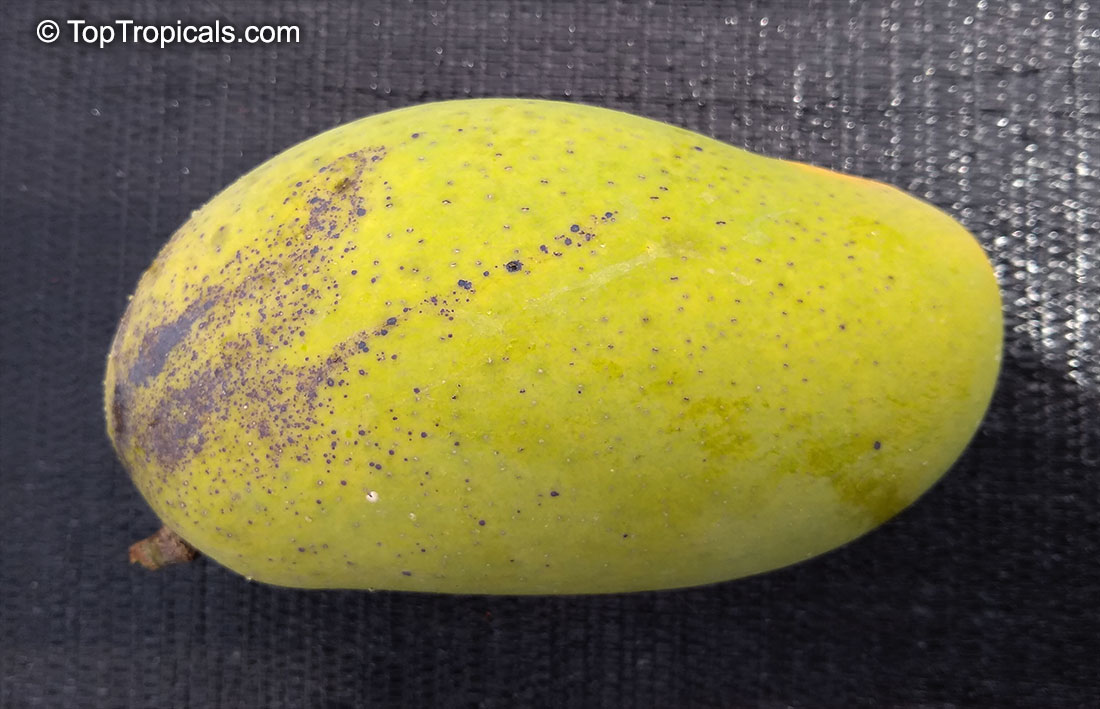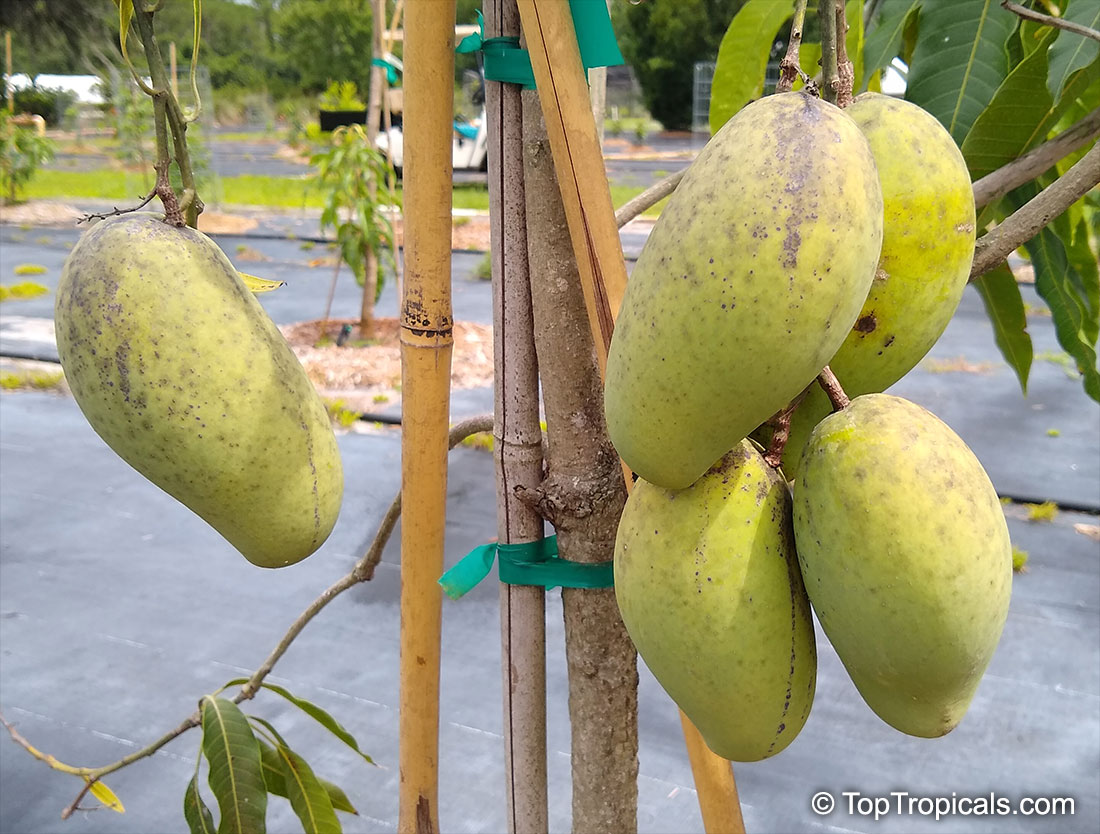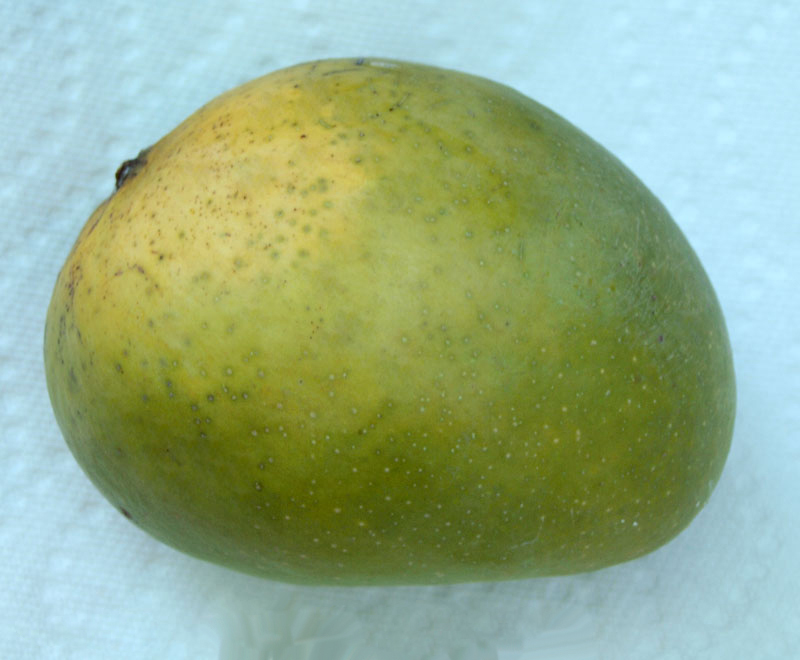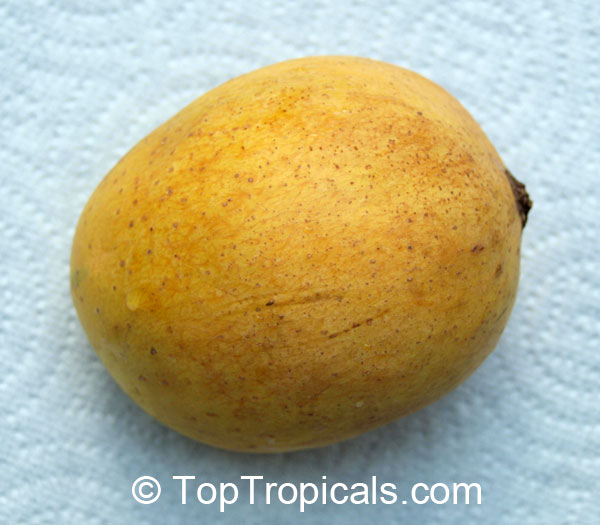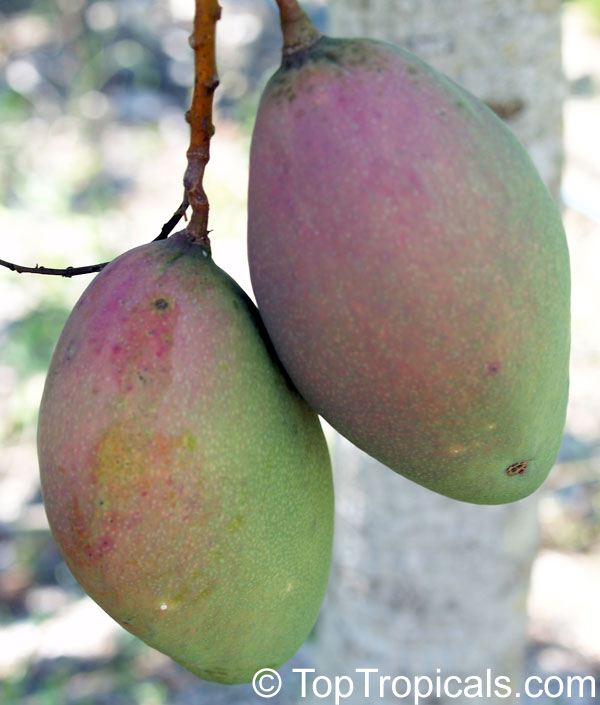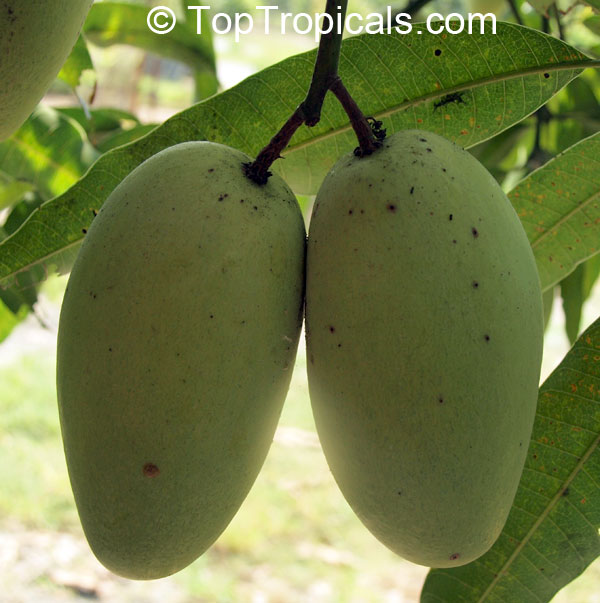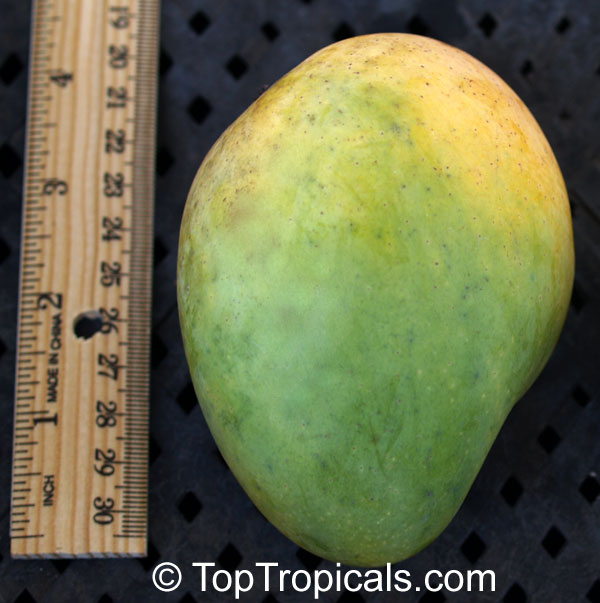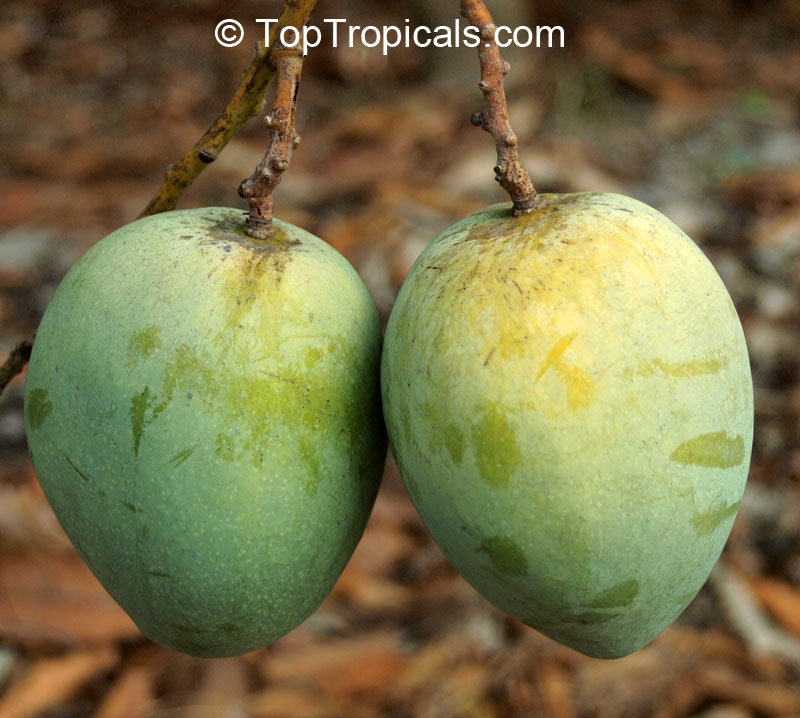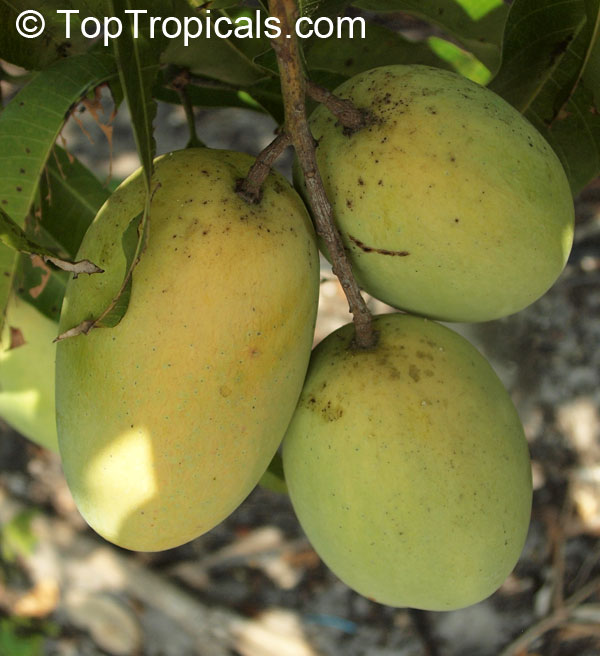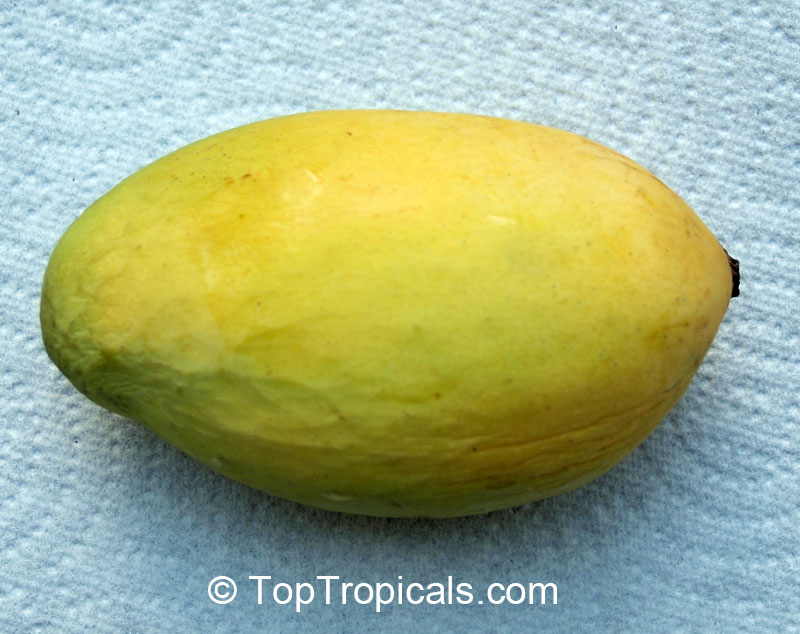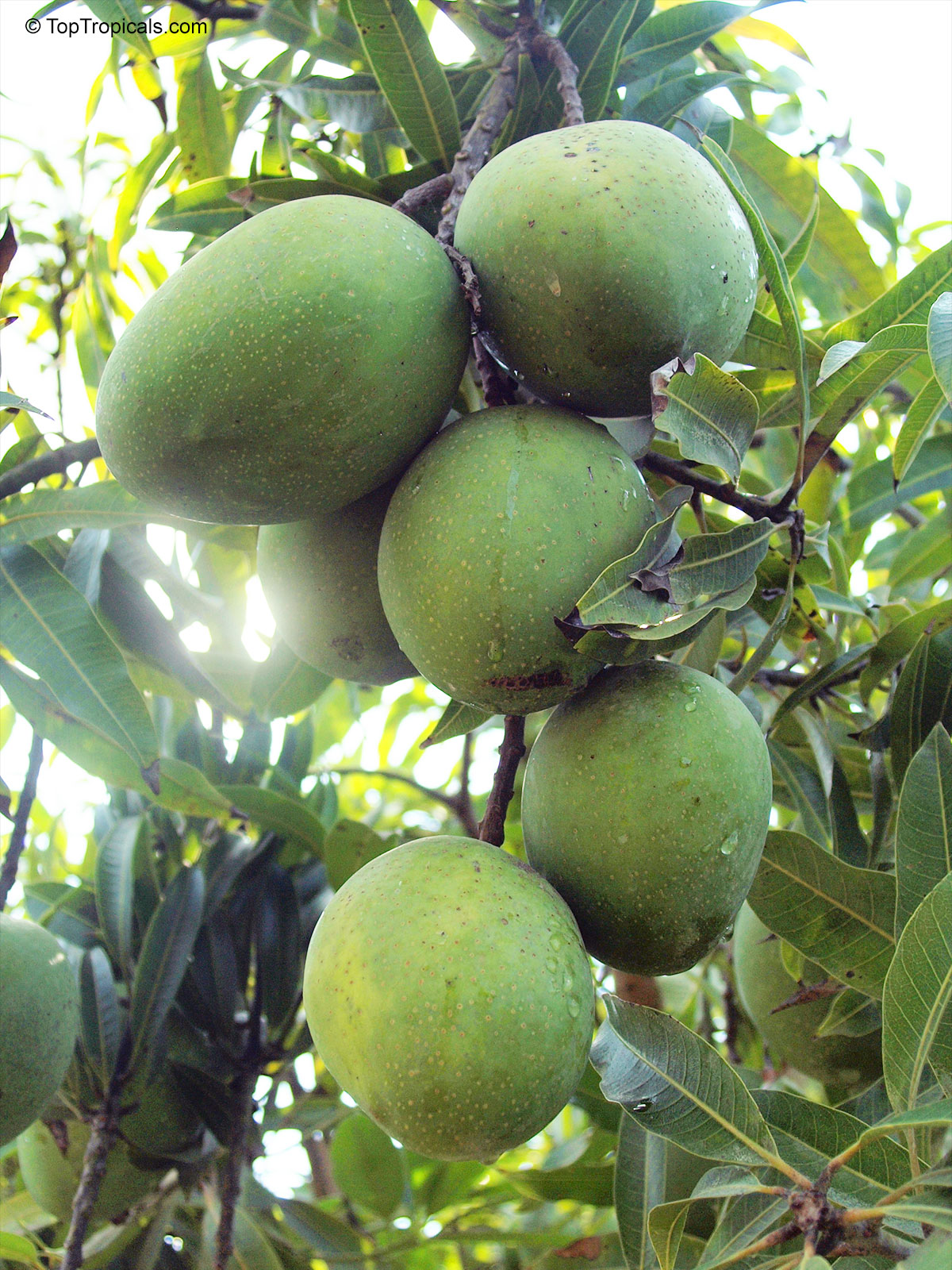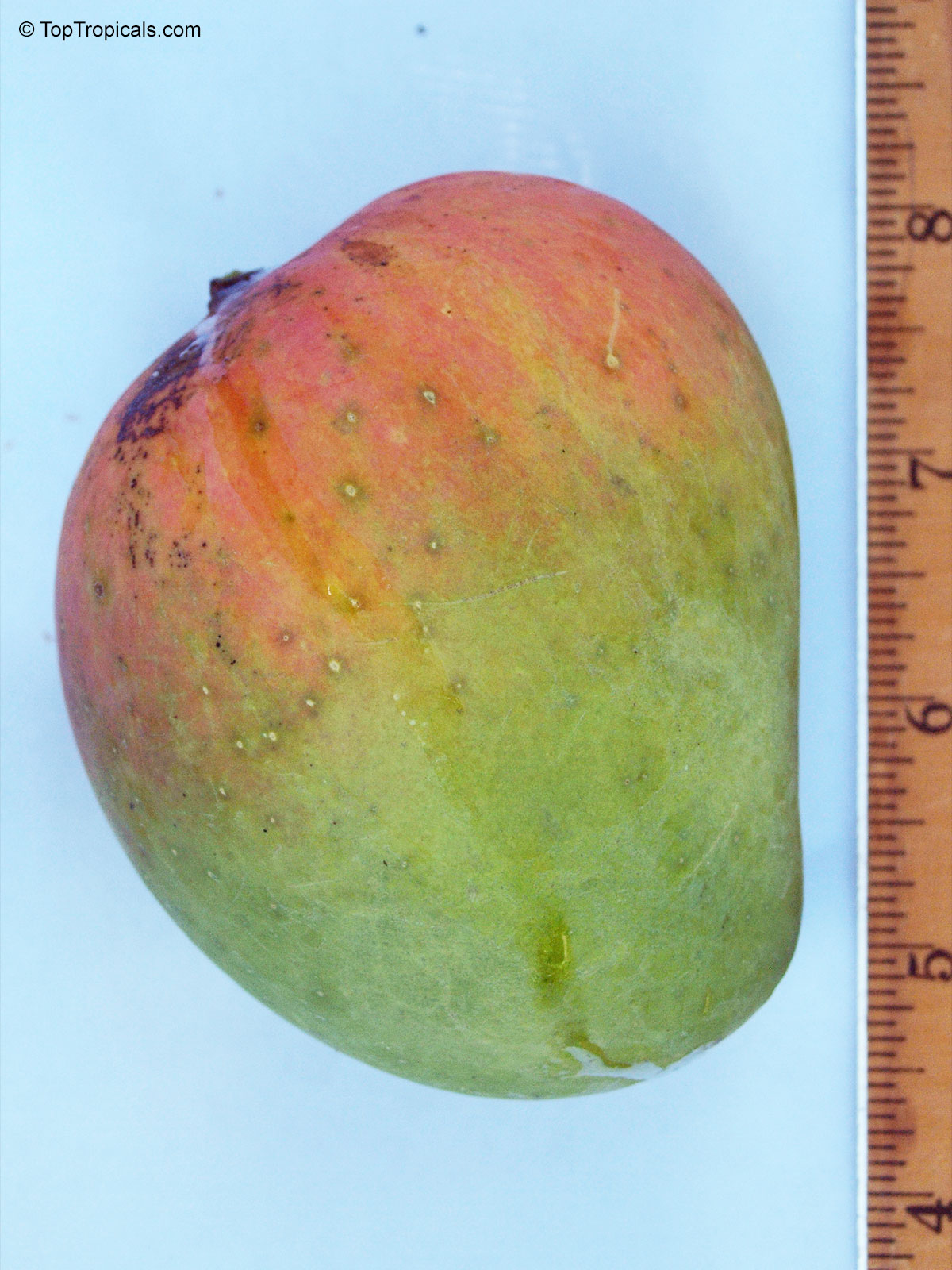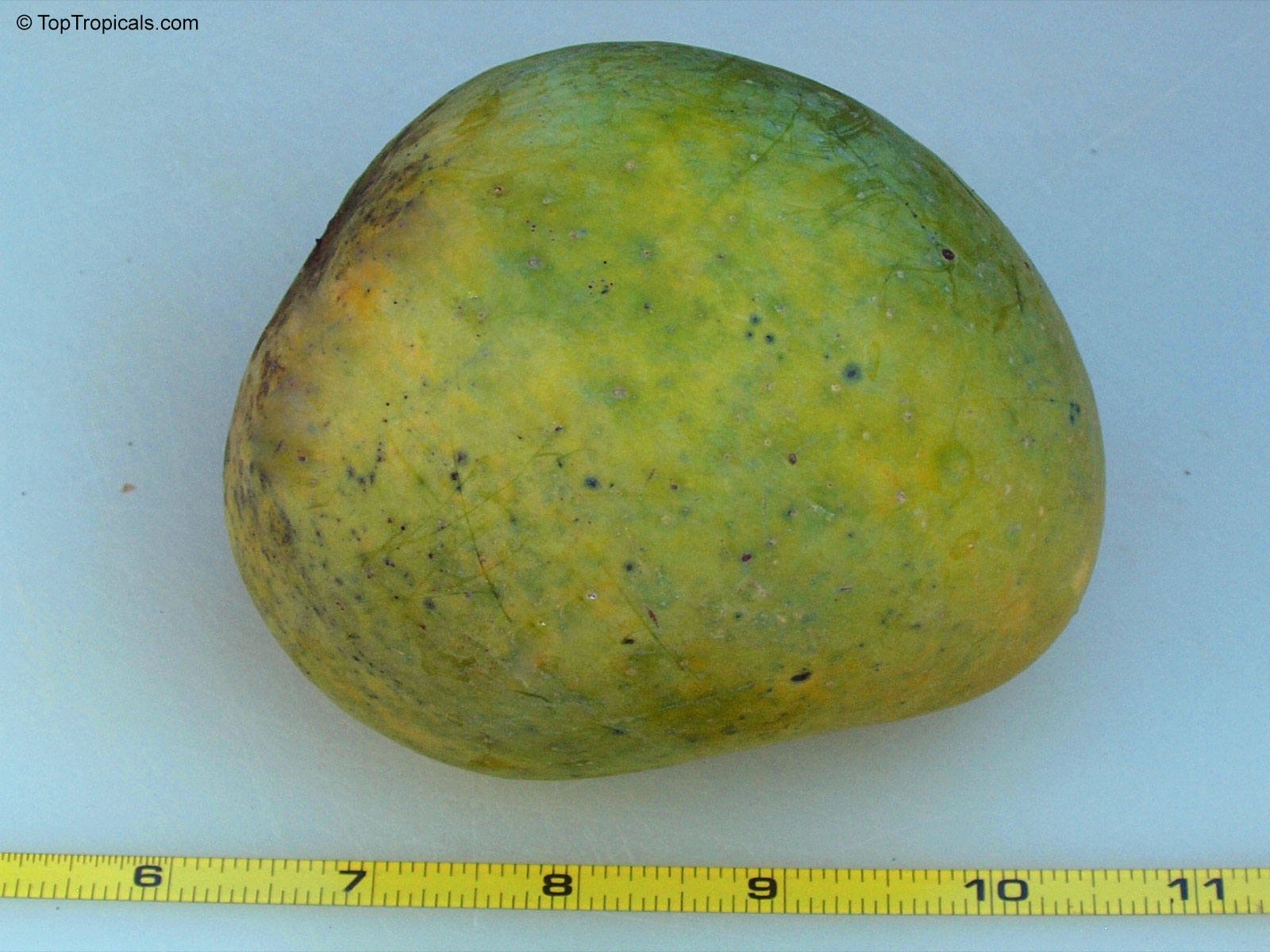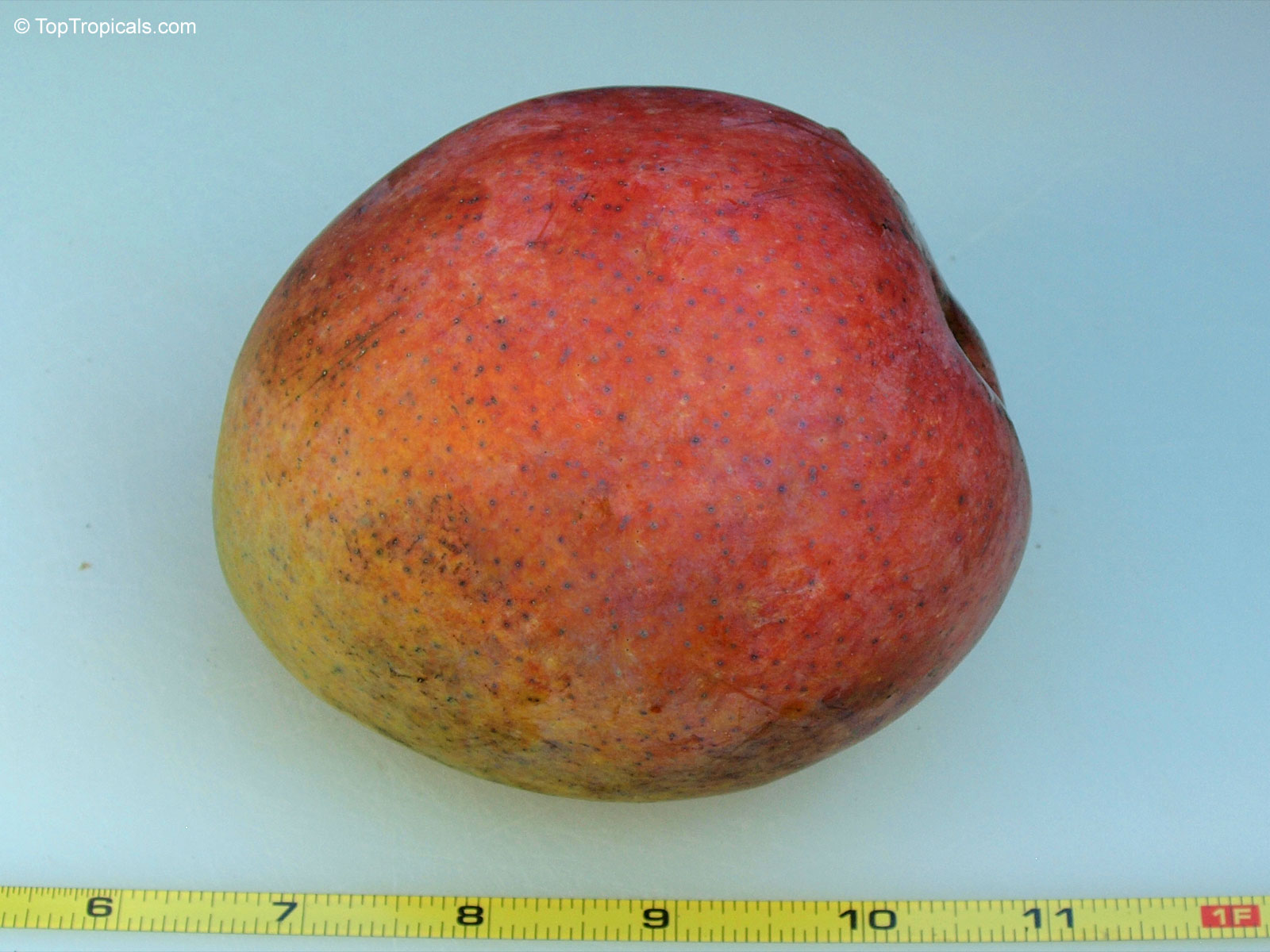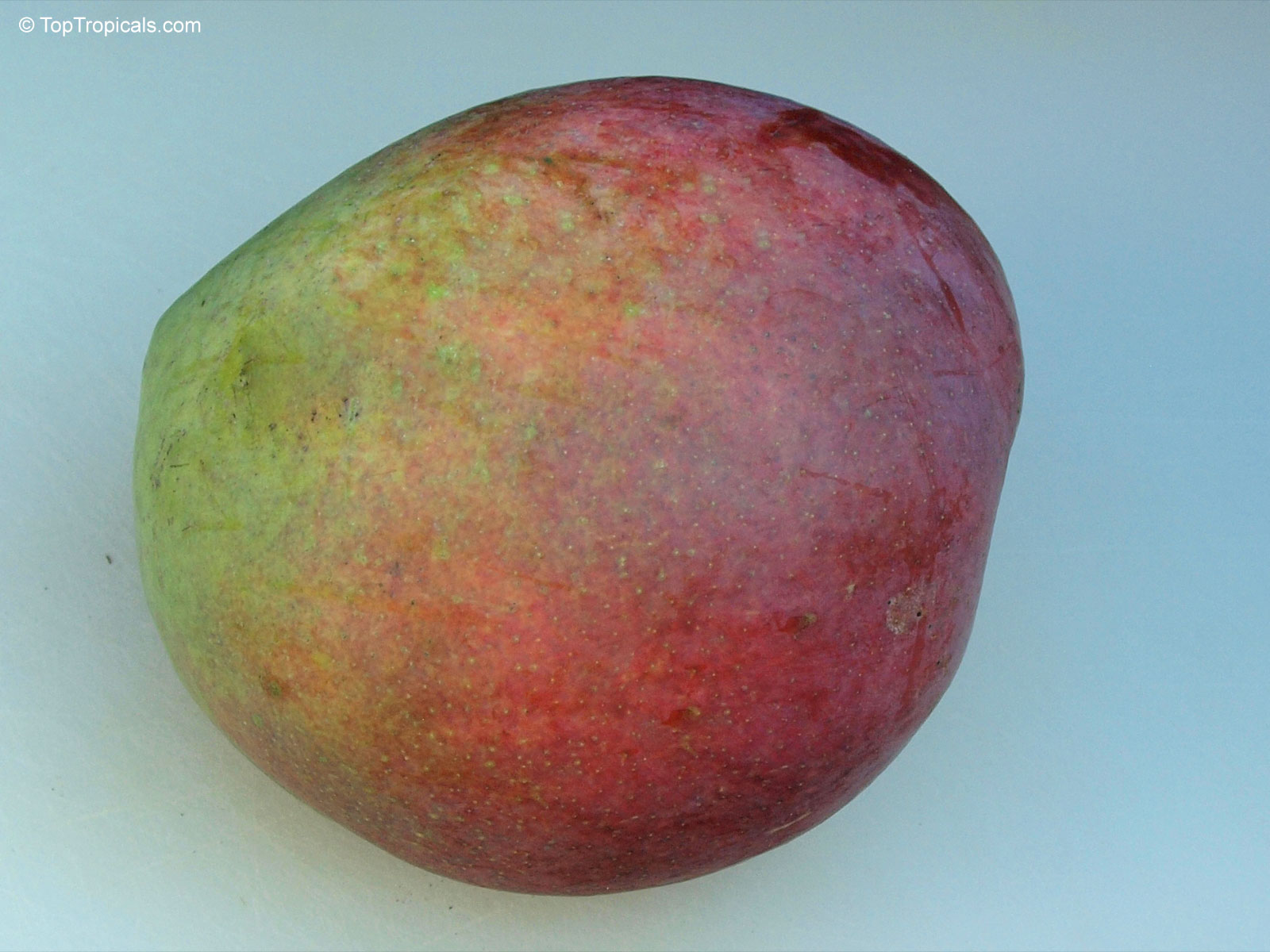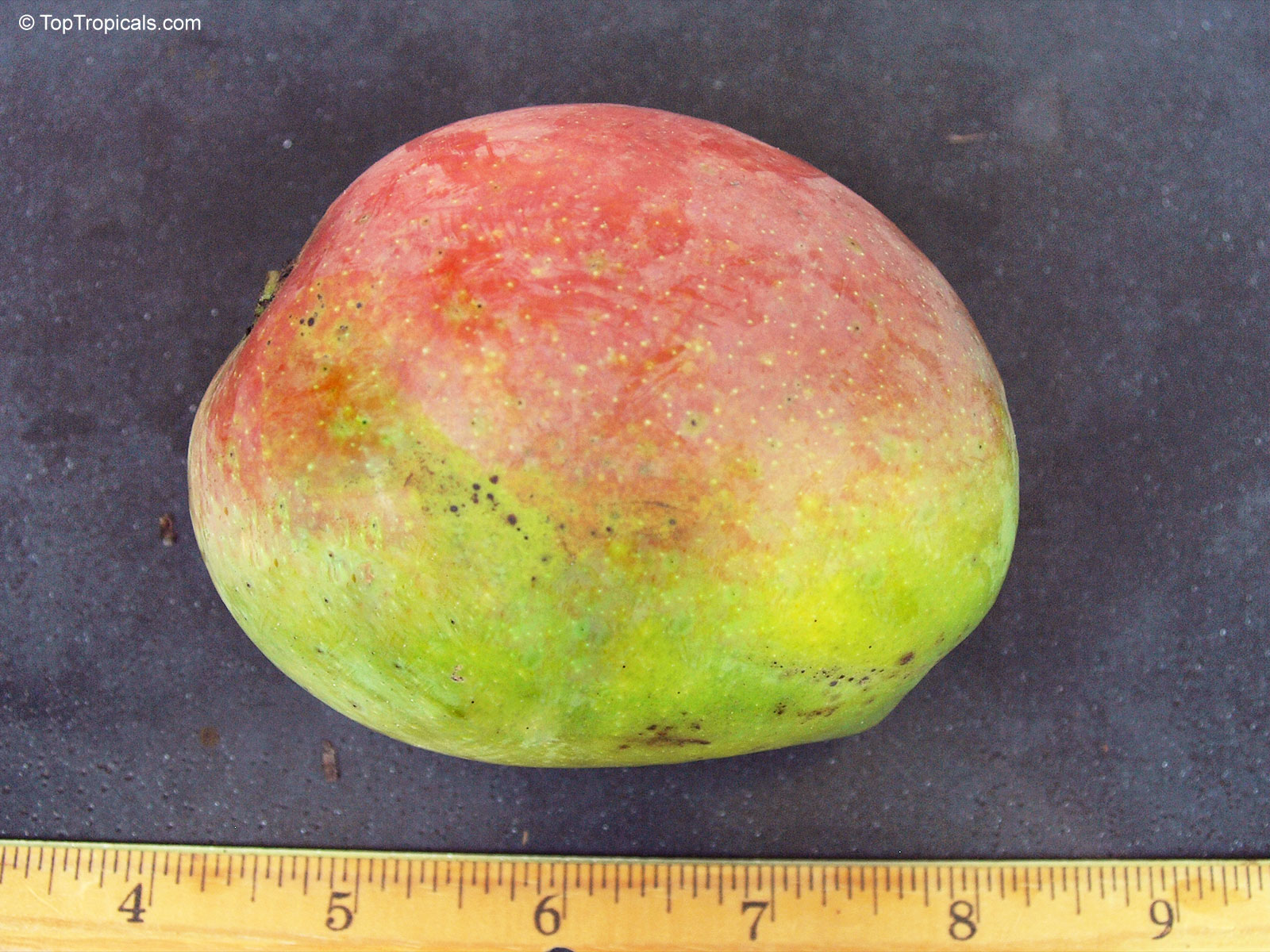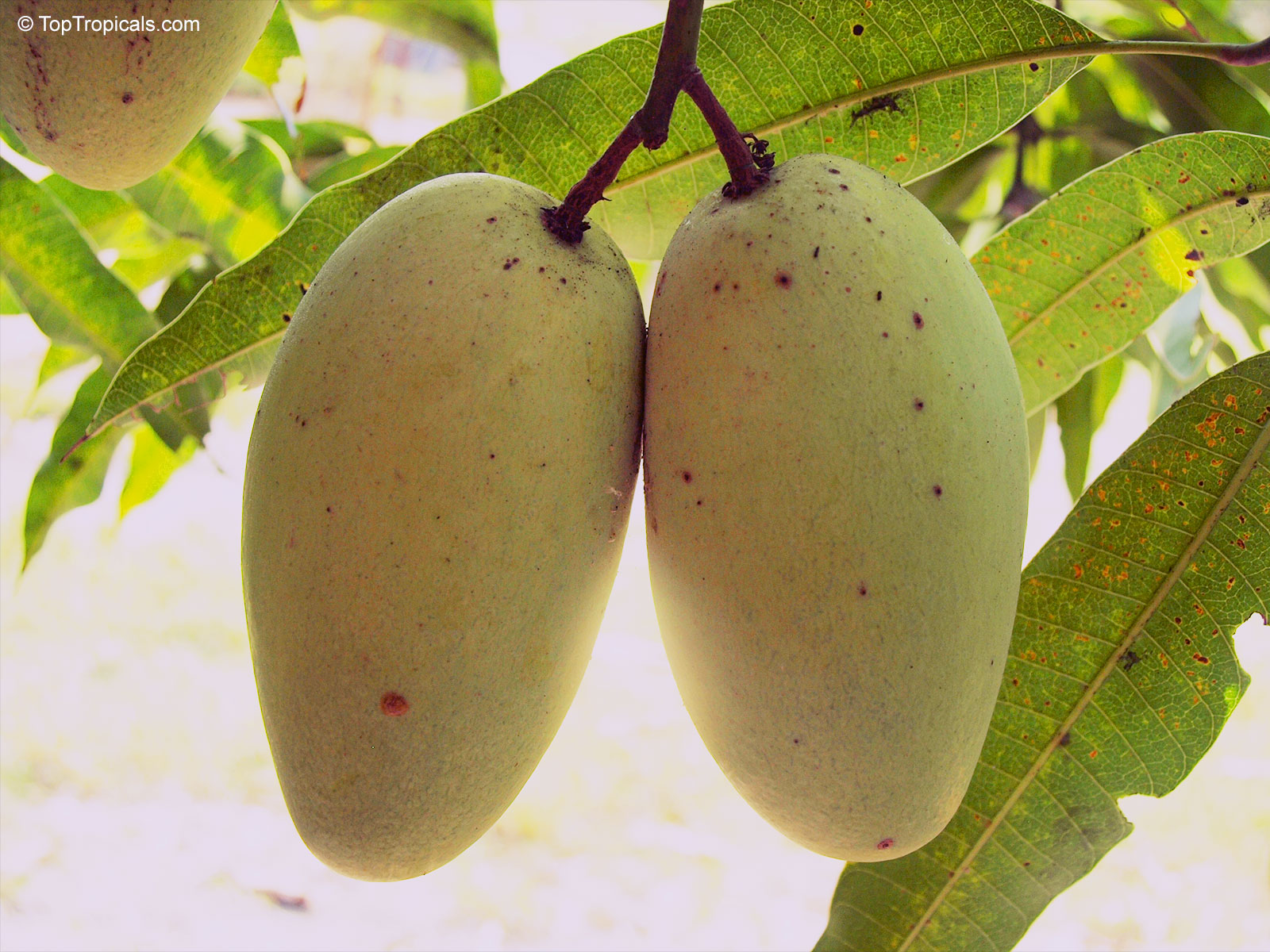Mangifera - Search results
Top Tropicals Plant Encyclopedia
| Number of plants found: 58 | Next | 
|
Go to page: | 1 | 2 | 3 | 4 | 5 | Last |
Botanical name: Mangifera caesia
Common names: Binjai, Malaysian Mango, Wani
Family: Anacardiaceae
Origin: Kalimantan, Borneo








Mangifera caesia (Binjai) is a big tree which can get taller than 20 feet and is native to Kalimantan, Borneo. Small varieties of this tree may not reach more than 10-20 feet and both full sun and semi-shade is suitable for growing these trees. Binjai tree requires regular watering and blooms with pink flowers.
Binjai trees are known for the production of edible fruits. Depending on the size of the tree and the size of the fruits requested, the number of fruits produced can vary. The fruits of Binjai tree are sour in the wild form but if it is cultivated in Bali or Borneo, the fruits can become sweet and fibreless. The white juice of immature Binjai fruit is poisonous, so it is very irritant while touching the skin or when ingested directly.
Apart from being edible, these fruits have several health benefits and are used for medicinal purposes. It is rich in Vitamin C and helps treat abdominal problems, cholesterol, skin inflammation, and urinary tract infections. The fruits can also be eaten raw, juiced, cooked or made into different varieties of jams and jelly.
Growing Binjai trees in a pot is recommended if you live in a cold region. To get the best growth and fruit production, pay attention to drainage, water, and light requirements. This plant needs plenty of water and full sun to grow and mature. However, during the hot summer months, you should provide some shade to protect the plant from overheating.
Botanical name: Mangifera casturi
Common names: Kalimantan Mango, Kasturi
Family: Anacardiaceae
Origin: Indonesia





The flesh of this fruit is orange in color and the texture stringy with a unique sweet fragrance. If we compare the Kasturi with the Mango (Mangifera indica), the Kasturi tastes less sweet but has a stronger taste and has a softer aroma.
Related Products: Mangifera casturi (Kalimantan Mango)
See more info about Mango varieties.
Recommended Fertilizer: SUNSHINE Mango Tango - Mango Tree Booster
SUNSHINE-Honey - sugar booster
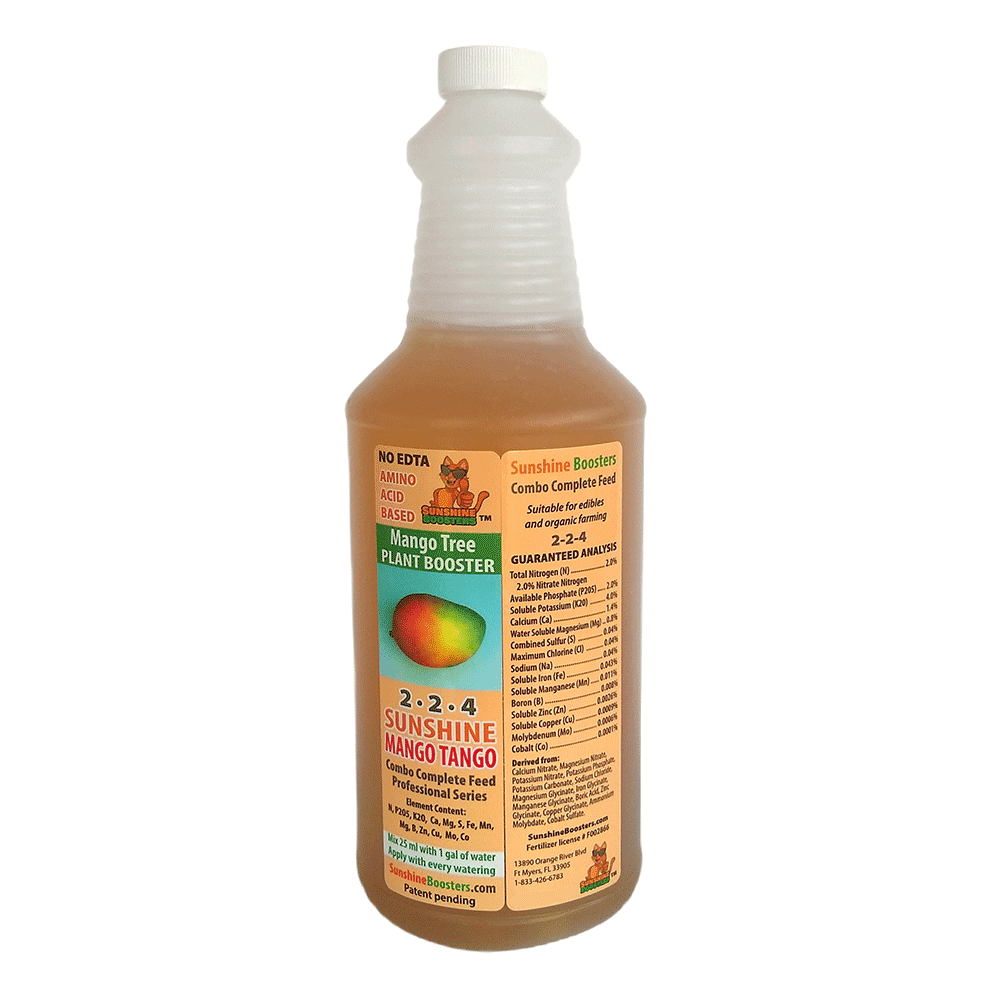 SUNSHINE Mango Tango (NPK 2-2-4) - eco-friendly concentrated nutrition booster for Mango trees. Helps to produce strong growth, high yield, larger fruit size. Improves quantity and quality of flowers and ability to set fruit. Encourages profuse blooming and reduces bud-flower-fruit drop. Can be used as often as with every watering. For best results, use in combination with Sunshine Honey and Sunshine Superfood plant supplements.
SUNSHINE Mango Tango (NPK 2-2-4) - eco-friendly concentrated nutrition booster for Mango trees. Helps to produce strong growth, high yield, larger fruit size. Improves quantity and quality of flowers and ability to set fruit. Encourages profuse blooming and reduces bud-flower-fruit drop. Can be used as often as with every watering. For best results, use in combination with Sunshine Honey and Sunshine Superfood plant supplements. Scientifically-balanced stable formula is organic Amino-acid based and has NO EDTA chelators to eliminate nutrients lockup; it does not affect crop taste. Organic Amino acids greatly enhance stability of all Sunshine boosters and provide excellent absorption of trace elements. Pollinating insects friendly.
DIRECTIONS: Mix 25 ml with 1 gal of water. Can be used with every watering, year around. Compatible with other Sunshine Boosters. Do not mix with other concentrated fertilizers.
Element Content: N, P2O5, K2O, Ca, Mg, S, Fe, Mn, Mg, B, Zn, Cu, Mo, Co. Fertilizer license # F002866.
For more information, download Sunshine Combo Boosters guide (2 pages) and see website SunshineBoosters.com.
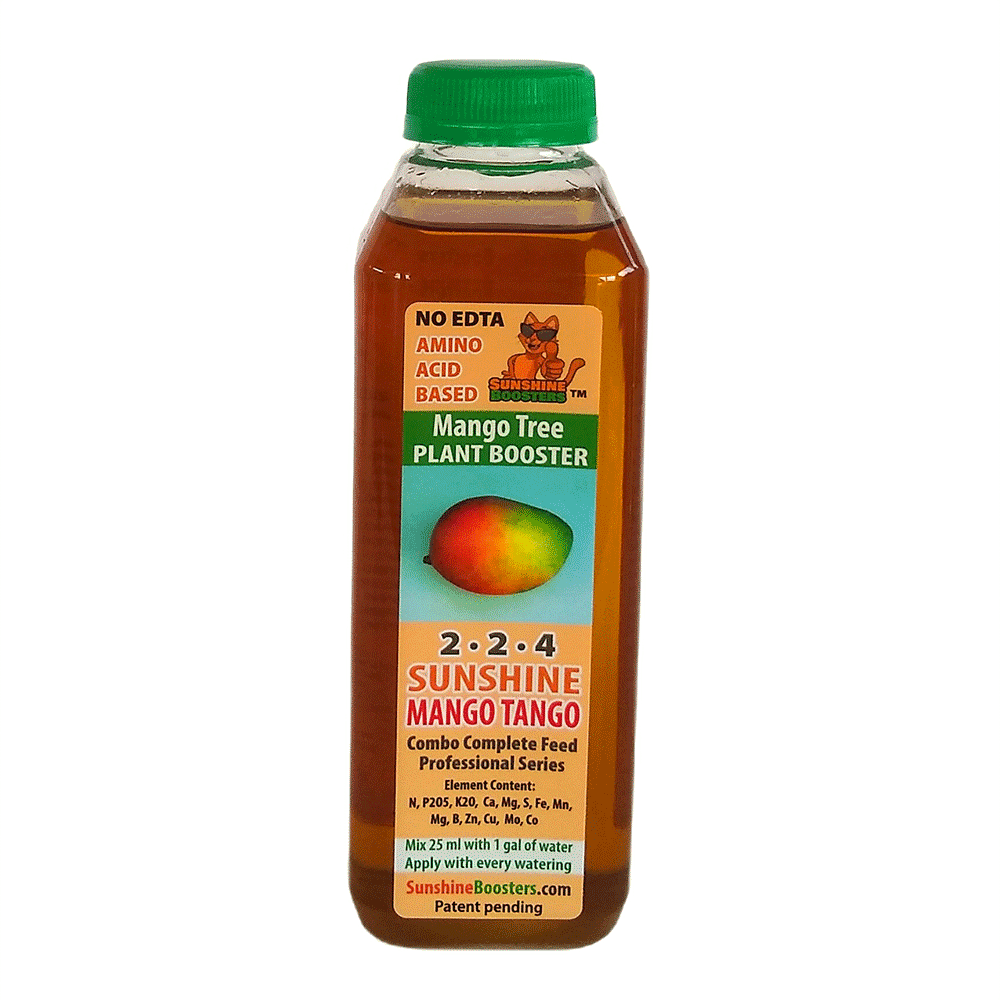 SUNSHINE Mango Tango (NPK 2-2-4) - eco-friendly concentrated nutrition booster for Mango trees. Helps to produce strong growth, high yield, larger fruit size. Improves quantity and quality of flowers and ability to set fruit. Encourages profuse blooming and reduces bud-flower-fruit drop. Can be used as often as with every watering. For best results, use in combination with Sunshine Honey and Sunshine Superfood plant supplements.
SUNSHINE Mango Tango (NPK 2-2-4) - eco-friendly concentrated nutrition booster for Mango trees. Helps to produce strong growth, high yield, larger fruit size. Improves quantity and quality of flowers and ability to set fruit. Encourages profuse blooming and reduces bud-flower-fruit drop. Can be used as often as with every watering. For best results, use in combination with Sunshine Honey and Sunshine Superfood plant supplements. Scientifically-balanced stable formula is organic Amino-acid based and has NO EDTA chelators to eliminate nutrients lockup; it does not affect crop taste. Organic Amino acids greatly enhance stability of all Sunshine boosters and provide excellent absorption of trace elements. Pollinating insects friendly.
DIRECTIONS: Mix 25 ml with 1 gal of water. Can be used with every watering, year around. Compatible with other Sunshine Boosters. Do not mix with other concentrated fertilizers.
Element Content: N, P2O5, K2O, Ca, Mg, S, Fe, Mn, Mg, B, Zn, Cu, Mo, Co. Fertilizer license # F002866.
For more information, download Sunshine Combo Boosters guide (2 pages) and see website SunshineBoosters.com.
Botanical names: Mangifera foetida, Mangifera odorata, Mangifera oblongifolia
Common names: Kuwini, Horse Mango, Malmut, Limus, Machang, Bachang, Kuini
Family: Anacardiaceae
Origin: Indonesia









A Medium-sized tree. This tree has a very unique feature. It emits a charaecteristic fragrant smell. Even the flowers of this tree are strongly scented with the same fragrance. That is why this species has been named M. odorata. This fruit has never been found in the wild. Botanists are of the opinion that Kuwini (M. odorata) has originated as a hybrid between Mangifera indica and Mangifera foetida.
This fruit is commonly cultivated in Borneo, Sumatra and Java. It is also found in Thailand, Vietnam and Guam Islands. The Kuwini is a popular fruit, having local economic significance in areas where Mangifera indica cannot be grown satisfactorily because of excessive humidity. Kuwini can produce two crops a years in areas where two dry seasons prevail.
Fruit are much appreciated as table fruit. They must be peeled thick because of the presence of an acrid juice in the skin, which can also be reduced by steeping in diluted lime-water before eating.
The fruits are also used for making chutney and for pickles with salt. In Java a kind of flour is made of the seed kernels and used in the preparation of delicacies such as dodol (based on glutinous rice) and jenang pelok (a thick pappy preparation from Curcuma rhizomes).
Propagated by seed, only rarely by grafting.
The sap is an irritant which may inflame the lips and mouth.
Mangifera foetida fruit is very similar in appearance to the Mango. Ripe Horse Mango fruit is usually eaten fresh. Young fruits contain irritant juice and must be soaked.
Botanical name: Mangifera indica
Common name: Mango
Family: Anacardiaceae
Origin: South Asia and India
Hardiness: 30°F









Mangifera indica (Mango) is a large evergreen tree native to South Asia and among the oldest cultivated fruit trees, grown in India for over 4,000 years. In tropical climates it can reach 60-80 feet with a broad crown of glossy leaves. Small yellowish flowers appear in spring, followed by fleshy drupes known worldwide as mangoes.
Fruit shape varies from oval to kidney-shaped, with skin that may remain green or ripen to yellow, orange, or red. The flesh is juicy and aromatic, sometimes fiberless and sweet, sometimes more resinous depending on type. Mangoes are eaten fresh, dried, blended, or cooked, making them one of the most versatile tropical fruits. Some people experience irritation on the lips from the peel, so fruits are usually eaten peeled.
The tree thrives in full sun and well-drained soil in warm climates, hardy only to USDA Zones 9-11. With hundreds of named cultivars, Mangifera indica remains one of the world s most widely grown and culturally important fruit trees.
See Mango varieties.
Related Products: Mangifera indica (Mango)
See more info about Mango varieties.
This item can not be shipped. Pick up only. We can provide local delivery around Ft. Myers or Sebring, Florida. Contact us for an estimate. Non-pickup orders are subject to restocking fees.
Recommended Fertilizer: SUNSHINE Mango Tango - Mango Tree Booster
SUNSHINE-Honey - sugar booster
See more info about Mango varieties.
Recommended Fertilizer: SUNSHINE Mango Tango - Mango Tree Booster
SUNSHINE-Honey - sugar booster
The trees are considered semi-dwarf and easy to manage through pruning. The disease tolerance is excellent and given its early season it often can be harvested before the rainy season in South Florida. The tree is semi-dwarf and highly manageable with annual pruning. Size can be maintained at or below 8 ft with consistent production.
See more info about Mango varieties.
Recommended Fertilizer: SUNSHINE Mango Tango - Mango Tree Booster
SUNSHINE-Honey - sugar booster
The trees are considered semi-dwarf and easy to manage through pruning. The disease tolerance is excellent and given its early season it often can be harvested before the rainy season in South Florida. The tree is semi-dwarf and highly manageable with annual pruning. Size can be maintained at or below 8 ft with consistent production.
See more info about Mango varieties.
This item can not be shipped. Pick up only. We can provide local delivery around Ft. Myers or Sebring, Florida. Contact us for an estimate. Non-pickup orders are subject to restocking fees.
Recommended Fertilizer: SUNSHINE Mango Tango - Mango Tree Booster
SUNSHINE-Honey - sugar booster
Last one
See more info about Mango varieties.
Recommended Fertilizer: SUNSHINE Mango Tango - Mango Tree Booster
SUNSHINE-Honey - sugar booster
See more info about Mango varieties.
This item can not be shipped. Pick up only. We can provide local delivery around Ft. Myers or Sebring, Florida. Contact us for an estimate. Non-pickup orders are subject to restocking fees.
Recommended Fertilizer: SUNSHINE Mango Tango - Mango Tree Booster
SUNSHINE-Honey - sugar booster
Last one
See more info about Mango varieties.
Recommended Fertilizer: SUNSHINE Mango Tango - Mango Tree Booster
SUNSHINE-Honey - sugar booster
See more info about Mango varieties.
This item can not be shipped. Pick up only. We can provide local delivery around Ft. Myers or Sebring, Florida. Contact us for an estimate. Non-pickup orders are subject to restocking fees.
Recommended Fertilizer: SUNSHINE Mango Tango - Mango Tree Booster
SUNSHINE-Honey - sugar booster
Last one
See more info about Mango varieties.
This item can not be shipped. Pick up only. We can provide local delivery around Ft. Myers or Sebring, Florida. Contact us for an estimate. Non-pickup orders are subject to restocking fees.
Recommended Fertilizer: SUNSHINE Mango Tango - Mango Tree Booster
SUNSHINE-Honey - sugar booster
See more info about Mango varieties.
This item can not be shipped. Pick up only. We can provide local delivery around Ft. Myers or Sebring, Florida. Contact us for an estimate. Non-pickup orders are subject to restocking fees.
Recommended Fertilizer: SUNSHINE Mango Tango - Mango Tree Booster
SUNSHINE-Honey - sugar booster
Last one
See more info about Mango varieties.
Recommended Fertilizer: SUNSHINE Mango Tango - Mango Tree Booster
SUNSHINE-Honey - sugar booster
See more info about Mango varieties.
Recommended Fertilizer: SUNSHINE Mango Tango - Mango Tree Booster
SUNSHINE-Honey - sugar booster
See more info about Mango varieties.
Recommended Fertilizer: SUNSHINE Mango Tango - Mango Tree Booster
SUNSHINE-Honey - sugar booster
Last one
See more info about Mango varieties.
7 gal pot. More developed root system, thicker trunk and branches. Plant height depends on growing season and variety. Dwarf varieties are slow growers and may be shorter. Contact us for exact size description if size/height matters to you. 7 gal plants may be shipped separately from other items by Ground service due to large size. See here time in transit (business days, excluding Sat-Sun!)
Recommended Fertilizer: SUNSHINE Mango Tango - Mango Tree Booster
SUNSHINE-Honey - sugar booster
Last one
Coconut Cream Mango - this variety is so exceptional, it is patented. Delicious, fabulous creamy coconut-mango flavor. Very large juicy fruit, and probably the most colorful! Brgiht red-orange-yellow. Flavor is exceptional with a coconut hint. Fiberless. Pulp is bright orange.
The green fruit have a nice characteristic of turning yellow on the bottom to show they should be picked soon. Trees grow moderately low and spreading. Should be pruned to shape. Ripening: June-July. Fruit size: 1 - 1.5 lbs.
See more info about Mango varieties.
Recommended Fertilizer: SUNSHINE Mango Tango - Mango Tree Booster
SUNSHINE-Honey - sugar booster
See more info about Mango varieties.
This item can not be shipped. Pick up only. We can provide local delivery around Ft. Myers or Sebring, Florida. Contact us for an estimate. Non-pickup orders are subject to restocking fees.
Recommended Fertilizer: SUNSHINE Mango Tango - Mango Tree Booster
SUNSHINE-Honey - sugar booster
See more info about Mango varieties.
This item can not be shipped. Pick up only. We can provide local delivery around Ft. Myers or Sebring, Florida. Contact us for an estimate. Non-pickup orders are subject to restocking fees.
Recommended Fertilizer: SUNSHINE Mango Tango - Mango Tree Booster
SUNSHINE-Honey - sugar booster
Last one
In the 18th century, Dasheri first appeared in the gardens of Nawab of Lucknow. Since then Dasheri plants have been produced and planted throughout India. People from the village Dasheri near Kakori, Uttar Pradesh have the mother plant. This mother plant belonged to the orchards of Late Mohammad Ansar Zaidi. This mother plant is said to be around 200 years old. It bears fruit every alternate year. Though the fruit is small when compared to its grafted counterparts, its flavor and aroma are unmatched. The plant is being well taken care of by Mr. Zaidi's descendants. It is often referred to as "The Mother Dasehri".
See more info about Mango varieties.
Recommended Fertilizer: SUNSHINE Mango Tango - Mango Tree Booster
SUNSHINE-Honey - sugar booster
Relatively cold hardy variety. See more info about Mango varieties.
Recommended Fertilizer: SUNSHINE Mango Tango - Mango Tree Booster
SUNSHINE-Honey - sugar booster
Last one
Relatively cold hardy variety. See more info about Mango varieties.
7 gal pot. More developed root system, thicker trunk and branches. Plant height depends on growing season and variety. Dwarf varieties are slow growers and may be shorter. Contact us for exact size description if size/height matters to you. 7 gal plants may be shipped separately from other items by Ground service due to large size. See here time in transit (business days, excluding Sat-Sun!)
Recommended Fertilizer: SUNSHINE Mango Tango - Mango Tree Booster
SUNSHINE-Honey - sugar booster
Last one
See more info about Mango varieties.
This item can not be shipped. Pick up only. We can provide local delivery around Ft. Myers or Sebring, Florida. Contact us for an estimate. Non-pickup orders are subject to restocking fees.
Recommended Fertilizer: SUNSHINE Mango Tango - Mango Tree Booster
SUNSHINE-Honey - sugar booster
Last one
See more info about Mango varieties.
This item can not be shipped. Pick up only. We can provide local delivery around Ft. Myers or Sebring, Florida. Contact us for an estimate. Non-pickup orders are subject to restocking fees.
Recommended Fertilizer: SUNSHINE Mango Tango - Mango Tree Booster
SUNSHINE-Honey - sugar booster
See more info about Mango varieties.
7 gal pot. More developed root system, thicker trunk and branches. Plant height depends on growing season and variety. Dwarf varieties are slow growers and may be shorter. Contact us for exact size description if size/height matters to you. 7 gal plants may be shipped separately from other items by Ground service due to large size. See here time in transit (business days, excluding Sat-Sun!)
Recommended Fertilizer: SUNSHINE Mango Tango - Mango Tree Booster
SUNSHINE-Honey - sugar booster
Last one
See more info about Mango varieties.
Recommended Fertilizer: SUNSHINE Mango Tango - Mango Tree Booster
SUNSHINE-Honey - sugar booster
Recommended Fertilizer: SUNSHINE Mango Tango - Mango Tree Booster
SUNSHINE-Honey - sugar booster
Botanical name: Mangifera indica Alampur Baneshan
Common name: Alampur Baneshan Mango
Cultivar: 'Alampur Baneshan'
Family: Anacardiaceae
The 'Alampur Baneshan' mango, sometimes spelled 'Banishan', is a traditional mango cultivar from South India and is regarded locally as one of the country's finest dessert types. The tree grows vigorously and develops a broad canopy, producing large oblique-oblong fruit that average 14-16 ounces. Even when fully ripe the skin remains green, often with a surface dotted by characteristic corky speckles. The flesh inside is fiberless, aromatic, and renowned for a complex, layered taste that blends resinous undertones with intense sweetness. This profile makes it highly esteemed among seasoned mango lovers, though its strong character can surprise those more accustomed to mild-flavored varieties.
'Alampur Baneshan' thrives in full sun and well-drained soil with moderate watering. It flowers in spring and fruits in summer, with harvest recommended while the fruit is still firm and green, followed by ripening at room temperature for best flavor. Hardy only to USDA Zone 10-11, it requires frost protection but can be container-grown in cooler regions. While it is widely appreciated in India, the fruit remains uncommon in export markets and is best experienced fresh near its place of origin.
Botanical name: Mangifera indica Alphonso
Common name: Alphonso Mango
Cultivar: 'Alphonso'
Alphonso Mango is one of the most renowned mango cultivars, valued for its rich flavor, smooth texture, and deep golden color. The medium-sized fruit has bright yellow skin that develops a light blush when ripe. The pulp is fiberless, aromatic, and exceptionally sweet, with subtle notes of apricot, honey, and saffron. The tree forms a compact, rounded canopy and grows vigorously while remaining suitable for home gardens and container culture. Originating from India's Konkan coast, this variety has become a benchmark for premium mango quality and is widely used for desserts, juices, and export.
This variety performs best in warm subtropical to tropical climates with full sun and well-drained soil. It produces consistent crops under proper management and shows good disease tolerance. Alphonso Mango grows well in USDA Zones 10-11 and should be protected from cold temperatures below 35F. Fruits mature in late spring to early summer and are known for their rich aroma and outstanding flavor typical of the finest dessert mangoes.
Botanical name: Mangifera indica Baileys Marvel
Common name: Baileys Marvel Mango
Cultivar: 'Baileys Marvel'
Family: Anacardiaceae
Mangifera indica 'Baileys Marvel' (Baileys Marvel Mango) is a classic midseason Florida variety appreciated for its excellent flavor, attractive fruit, and reliable production. The medium to large fruit is oval and slightly flattened, with smooth yellow skin heavily blushed in shades of red and rose-pink over a golden background. Some fruit may retain green patches near the stem when fully mature. The deep orange flesh is juicy, nearly fiberless, and richly sweet with a hint of tropical spice. The flavor is smooth and balanced, similar to Haden but less fibrous and often preferred for fresh eating. The tree is moderately vigorous with a broad canopy and begins to bear early, producing consistent crops year after year.
Baileys Marvel performs best in tropical and subtropical climates and is valued for its good disease resistance and dependable yields. It ripens from June to August, making it one of the most rewarding summer mangoes for home gardens. Trees thrive in full sun and well-drained soil with regular watering and feeding during the growing season. They perform best in USDA Zones 10-11 and need protection from frost, with minimum tolerance down to about 30F.
Botanical name: Mangifera indica Beverly
Common name: Beverly Mango
Cultivar: 'Beverly'
Family: Anacardiaceae
Beverly Mango is a late-season variety valued for its excellent eating quality and smooth, fiberless texture. The large, rounded fruit has a greenish-gold skin that often develops a pink or rose blush on the sun-exposed side. Its flesh is deep orange, rich, and sweet with a pleasant tropical aroma and minimal acidity. The tree has a dense, spreading canopy and moderate vigor, making it ideal for home gardens and smaller spaces where size control is important. Beverly is known for its consistent production and for holding fruit well on the tree without splitting or dropping.
This cultivar performs best in warm subtropical climates with full sun and well-drained soil. It shows good resistance to anthracnose and other common mango diseases. Beverly Mango thrives in USDA Zones 10-11 and tolerates brief cool spells but must be protected from frost. Fruits typically ripen in mid to late summer, extending the mango season and providing a smooth, rich flavor that distinguishes it among late-bearing varieties.
Botanical name: Mangifera indica Bombay
Common name: Bombay Mango
Cultivar: 'Bombay'
Family: Anacardiaceae
Mangifera indica 'Bombay' (Bombay Mango) is a classic Indian variety introduced to the Caribbean and Florida many decades ago. It is famous for its rich, spicy-sweet flavor and smooth, fiberless flesh with a deep orange color. The medium to large fruits are slightly flattened and develop a striking yellow skin with a red blush when ripe. The tree has an open canopy and moderate vigor, making it a good choice for home gardens and collectors seeking old-world mango character.
Adapted to tropical and subtropical climates, 'Bombay' performs best in warm coastal regions and shows good resistance to common mango diseases. It is known to produce reliably once mature, typically fruiting from June to August in Florida conditions. Trees thrive in USDA Zones 10-11 and need protection from frost, with minimum tolerance down to about 30F.
Botanical name: Mangifera indica Cac
Common name: Cac Mango
Cultivar: 'Cac'
Family: Anacardiaceae
Mangifera indica 'Cac' is a popular Vietnamese mango cultivar known for its excellent eating quality and dependable productivity. Fruits are medium to large, oval to slightly oblong, with smooth green skin that turns yellow when ripe. The fiberless lemon-yellow flesh is juicy and aromatic, offering a flavor described as uncomplicated, blending citrus and peach tones with a gentle floral bouquet.
In cultivation, Cac thrives in warm, humid climates with full sun and fertile, well-drained soil. The tree has an open and somewhat leggy growth habit that requires careful tipping and shaping of branches to maintain structure and productivity. It benefits from regular watering and balanced fertilization during the growing season to ensure consistent yields. The tree adapts well to tropical and subtropical regions and is considered disease resistant compared to many other mangoes. This cultivar is not frost tolerant and should be grown in USDA Zones 10-11, with protection required if temperatures fall below 40-45 F.
Nothing found

